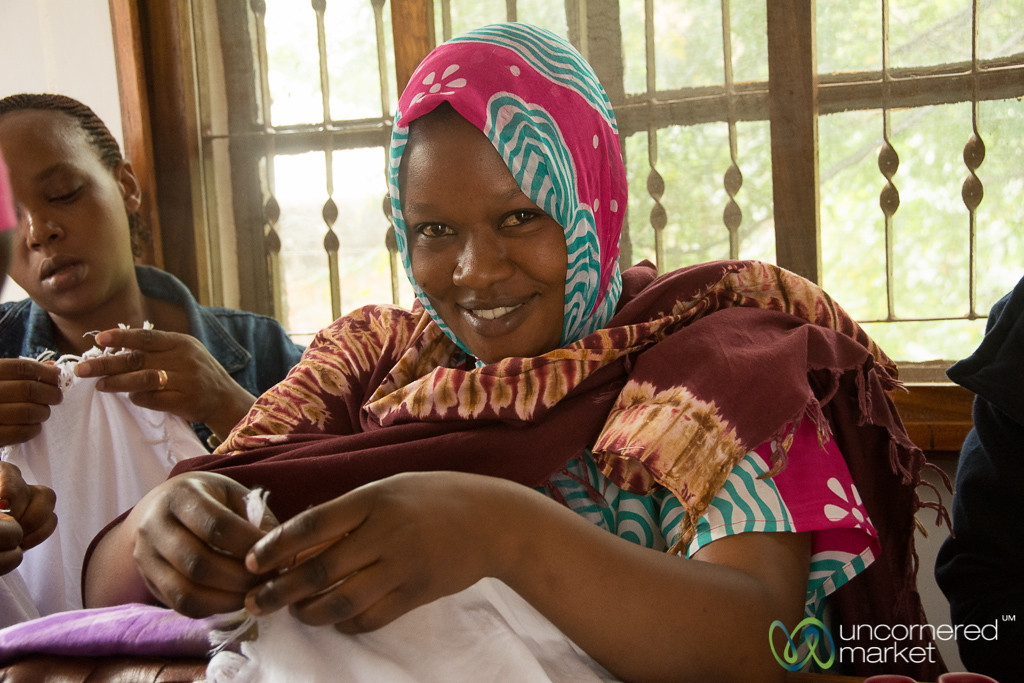Last Updated on November 23, 2022 by Audrey Scott The tires of our e-bikes rested on the cobbles of what we imagined was an old imperial road. Our early morning cycle had wound up through the meadows and canopies...
Last Updated on November 23, 2022 by Audrey Scott
The tires of our e-bikes rested on the cobbles of what we imagined was an old imperial road. Our early morning cycle had wound up through the meadows and canopies of a nature reserve carved out along the banks of the Tiber River in central Italy. A long stretch of road opened revealing veils of mist rising above the bends of water below.
As the road turned steeper still and narrowed, a 13th century castle with hill towns in view just behind it hinted at the medieval history around us, of struggles between barons and popes.
This is Lazio, a slice of Italy with all the archaeological, culinary, natural and romantic trappings you might expect but, for now at least, without the crowds.
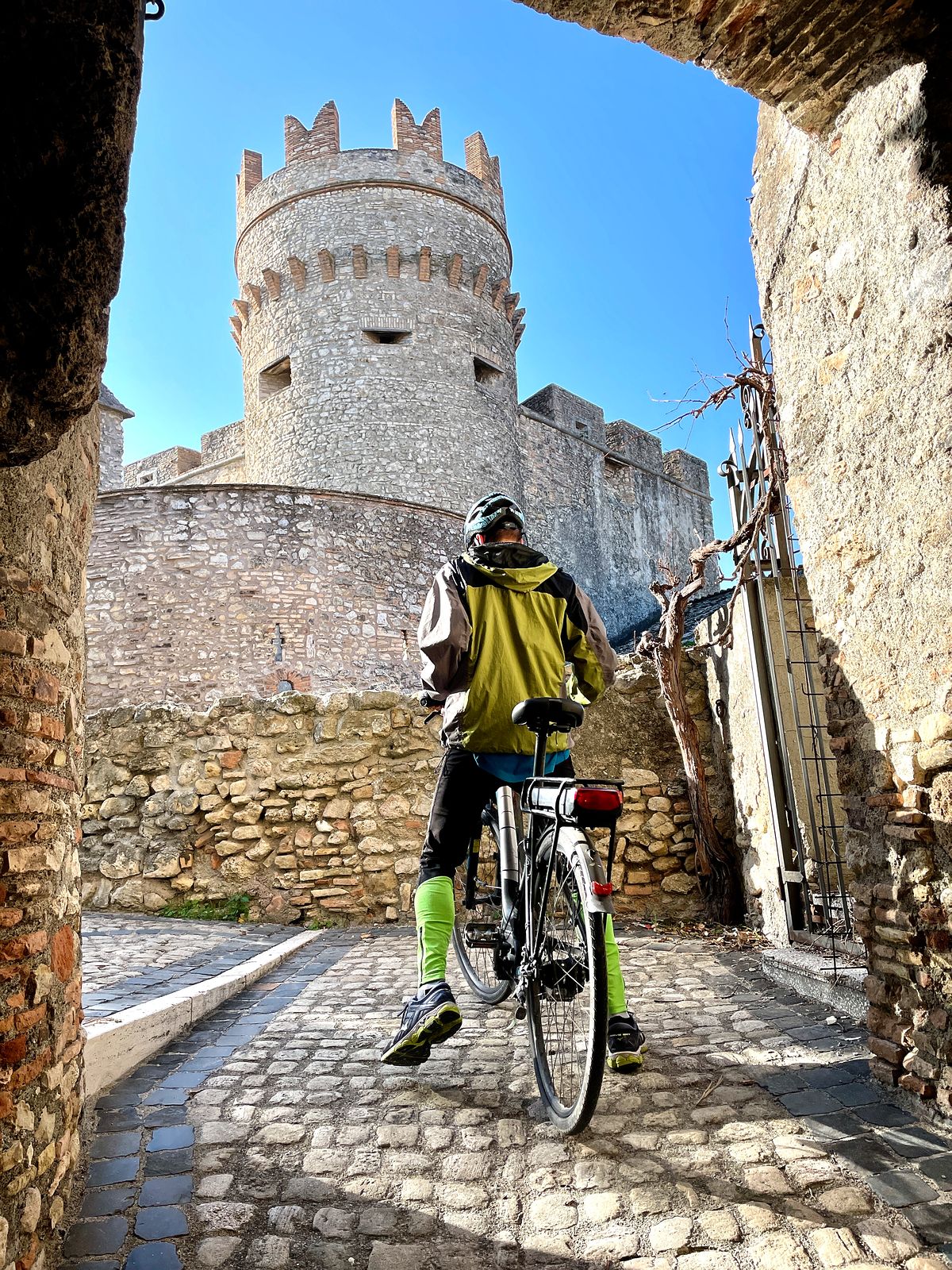 Storming the castle in Nazzano…by e-bike.
Storming the castle in Nazzano…by e-bike.Lazio, Italy: Wide Open
“Where is Lazio?” a friend asked when we first spoke of setting off on this trip.
Despite having visited Italy well over a dozen times since we married (in Tuscany), we knew little about Lazio prior to this project, one initiated by Thybris River Experience and funded by Lazio Region, one intended to craft new guided e-bike itineraries in the region.
If you felt the need to place yourself in the geographic center of Italy, you might not imagine Lazio, the regional home to Italy’s capital Rome. But it’s about where you’d be.
As our guide Giorgia unspooled her stories, she hinted that Lazio was pressed between the ritualized Etruscans to the north in Tuscany and the free-wheeling Bourbon-influenced provinces of southern Italy. In all ways, Lazio seems to teeter in between these worlds.
She also explained the word Lazio was derived from the Latin word latus meaning “wide.” While this referred to the low-lying areas around Rome, the idea of Lazio as “wide open”, including for exploration, grew on us as we spent more time. Much of what we experienced felt relatively undiscovered from a tourism perspective.
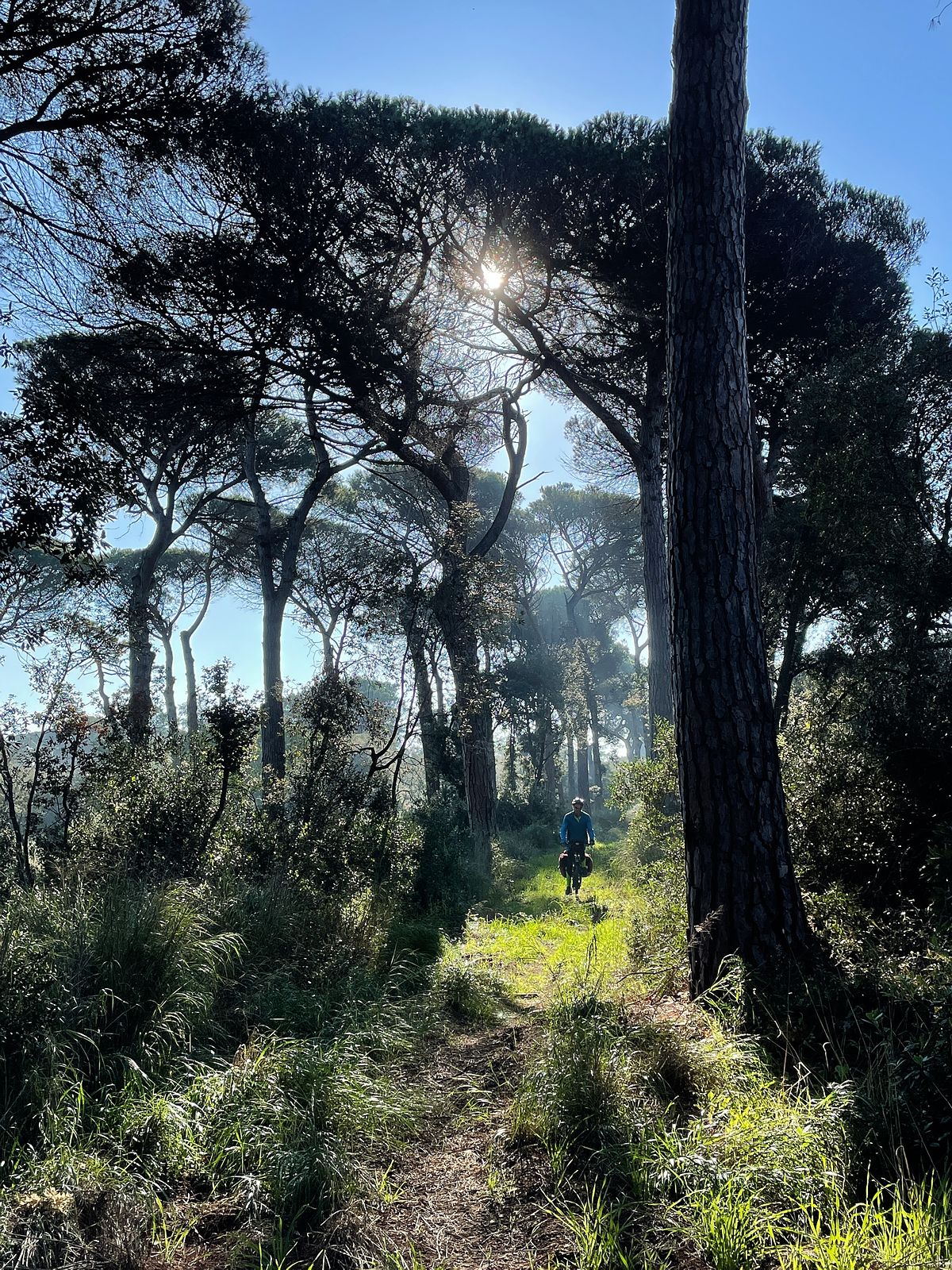 Cycling the pine forest of Castel Fusano outside Rome.
Cycling the pine forest of Castel Fusano outside Rome. From the well-preserved ancient echoes of Ostia Antica to the modern psychic imprint of Italian film greats and philosopher-poets like Pier Paolo Pasolini, this part of northern Lazio might bear a label that reads “greater Rome.” Yet our daily experience was more expansive. It featured hill town espresso breaks, hidden sculpture gardens, migratory bird hides, and overnights in restored villas, all punctuated with random encounters and mid-afternoon noshes on pastas turned in local products and paired with local wines.
Developing guided e-bike itineraries in Lazio
Our journey through Lazio included ten days' worth of e-bike rides in three distinct areas, each within about an hour's train ride from Rome. The goal of these three itineraries, which our involvement and feedback will help refine, is to enable travelers to engage with lesser-known hill towns, protected areas, cultural curiosities and historical sites in Lazio Region along the Tiber River as it winds its way from north of Rome, through the city and out to the Tyrrhenian Sea on Italy's west coast.?
The two- and three-day customizable trips connect travelers to still relatively unknown areas near Rome in a way that celebrates local communities, artisans and experiences.
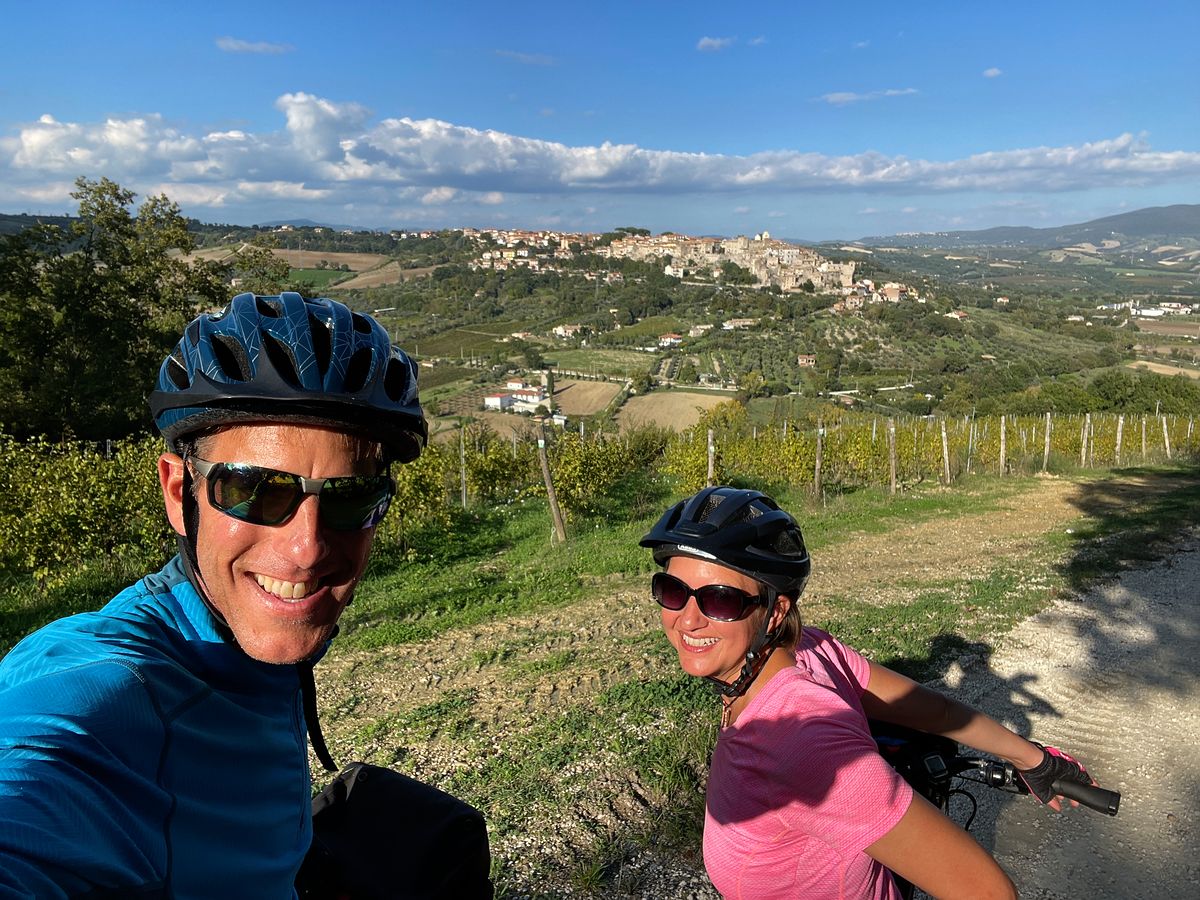 Cycling with e-bikes from hill town to hill town in Lazio.
Cycling with e-bikes from hill town to hill town in Lazio. Core to these guided tours are the concepts of sustainability, community, and a focus on all things local, including accommodation, guides, food, transport and providers. Although all destinations noted here can be accessed via other methods of transport, e-bikes featured as our primary mode of transport together with an occasional regional train. The aim: to maximize local benefit and minimize environmental impact.
Across three multi-day itineraries in Lazio, here are just some of the people and places you might encounter.
A big thanks goes to Giorgia Cadinu, a dynamic professional guide in Rome and cycling enthusiast. She initiated this project and shared her curiosity and passion for the Tiber River and Lazio Region with us all along the way. If you wish to book or customize any of the following guided itineraries, contact Thybris River Experience. Note that the website may refer to the tours as Pomona (Tuscia and Teverina), Bona Dea (Tevere Farfa Reserve and Nazzano), and Leucotea and Egeria (Ostia Antica, Fiumicino, and Isola Sacra into Rome) lands respectively.
1. Tuscia and Teverina: hill town and villa life
Just an hour outside Rome by train are the Tuscia and Teverina districts of northern Lazio on the border of Italy's Umbria and Tuscany regions. Despite the accessibility of these districts to the capital city, you'll find what feels like a completely different world — one defined by rolling landscapes, wine farms, and a spread of palazzi and manor houses which harken back to barons whose designs for power may have conflicted with a pope or two.
Explore the hill towns of Tuscia in Lazio by e-bike
While Tuscany and Umbria are famous for their hill towns, you’ll find the beauty of medieval hill towns with melodic names like Civitella d'Agliano, Celleno, Roccalvecce, Sippiciano and Vitorchiano perched high above the Tiber River valley in Lazio.
But these destinations come without the crowds, for now at least.
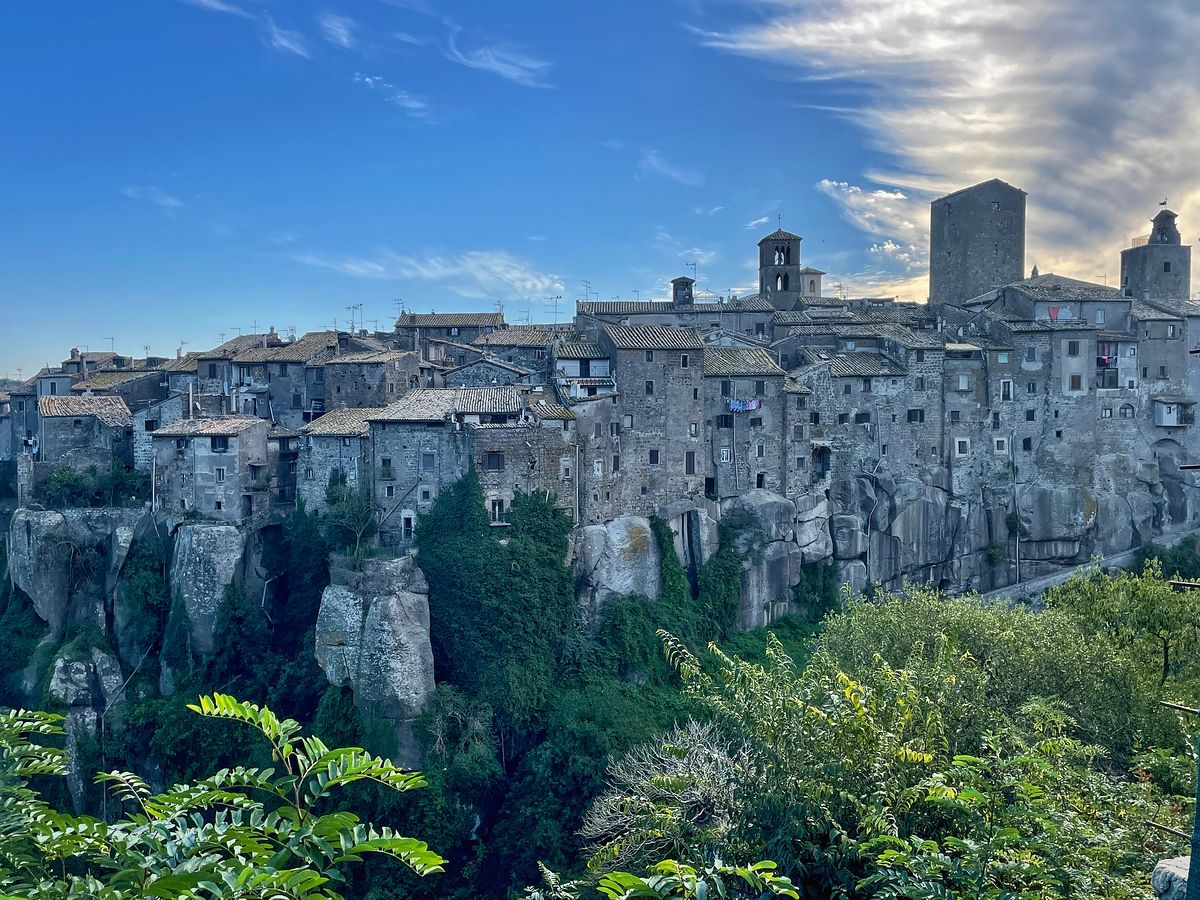 The town of Vitorchiano, perched cliffside and catching some early morning light.
The town of Vitorchiano, perched cliffside and catching some early morning light.
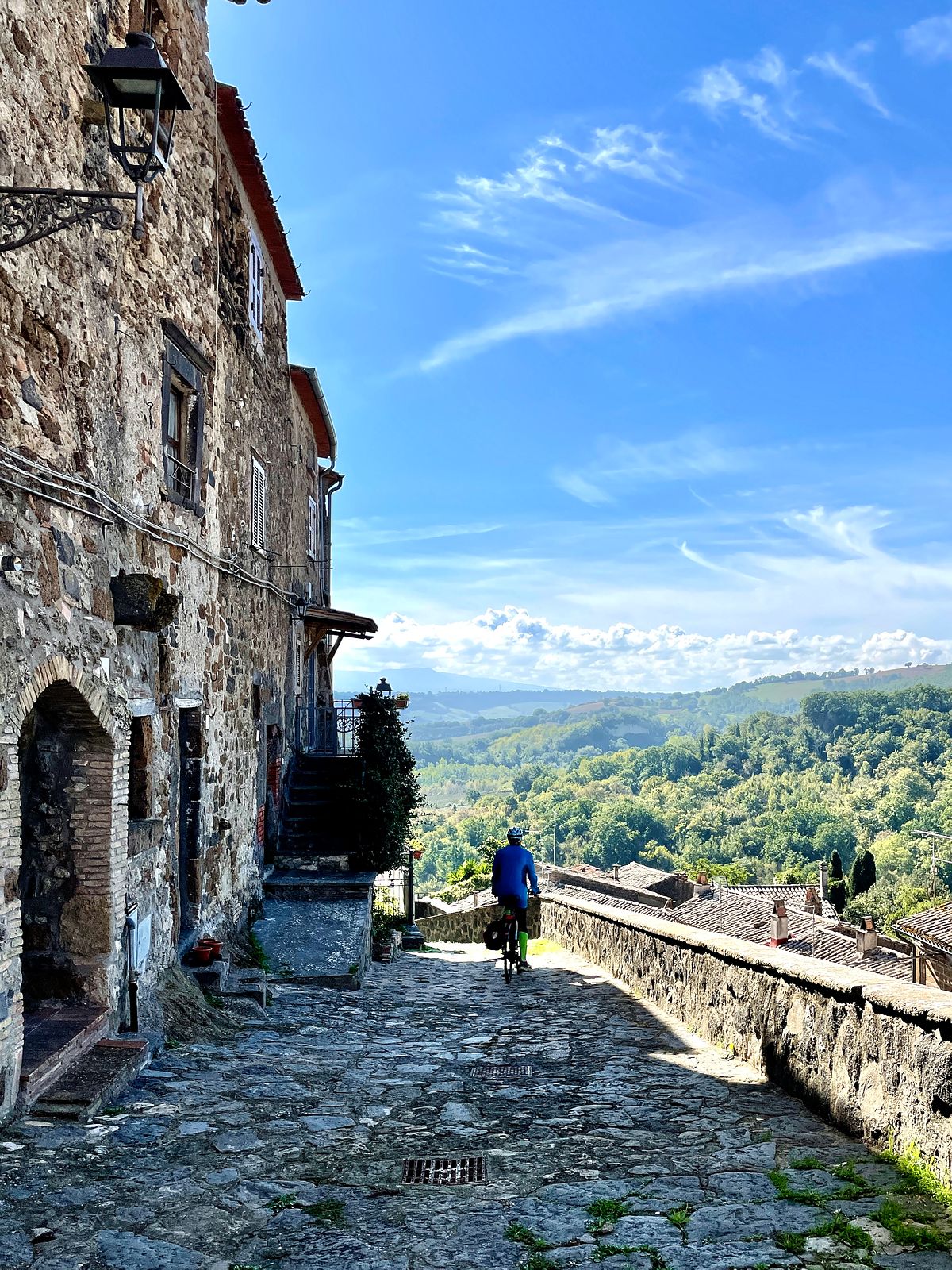 Cycling the medieval walls of the hill town of Roccalvecce.
Cycling the medieval walls of the hill town of Roccalvecce.
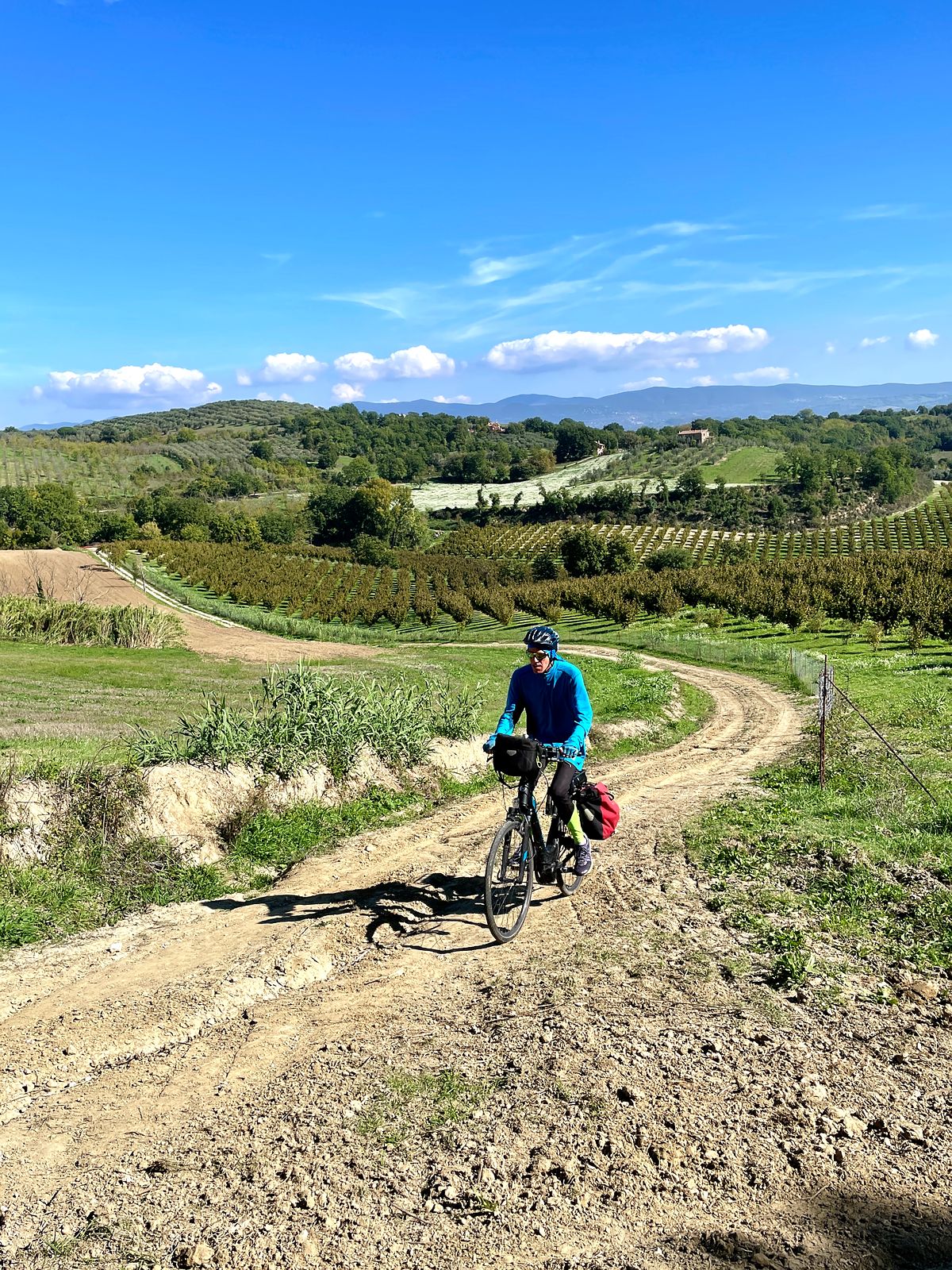 Over the hills and vineyard dale, Teverina by e-bike.
Over the hills and vineyard dale, Teverina by e-bike.
One of the benefits of traveling by e-bike from hill town to hill town around the region is the opportunity to appreciate the contours and changes in landscape, as well as the subtle shifts in character of the towns and townspeople along the way.
From forest to rolling hill to volcanic farm, our cycling journey from one destination to another delivered some of the most memorable and most photogenic experiences of the day.
Trebotti Wine Farm: Taste volcanic wines from a fully sustainable winery
While many wineries today have only just begun to focus on sustainability, Trebotti winery in the hills of Tuscia has made sustainability core to its family-run operations for over 20 years. During a tour, you'll see this considered in every detail: the (re)use of an ancient Etruscan cellar to store its sparkling wines, the choice to grow only indigenous grapes on its volcanic soils, the use of lightweight glass bottles, and an elaborate self-regulating air circulation system to reduce energy consumption. The goal of all this is to operate sustainably, to live up to the wine's organic label, to manage environmental impact and to find balance with nature.
If anyone wished to understand what sustainability looks like in detailed operation, this wine farm would be a great place to start.
Federico, our host, summed it up well: “To be sustainable is to respect the land.”
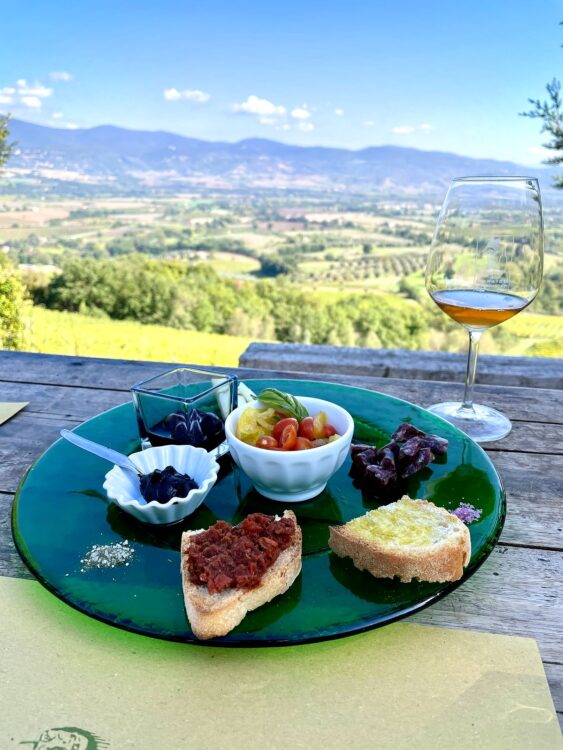 Wine tasting above the terraced vineyards at Trebotti winery.
Wine tasting above the terraced vineyards at Trebotti winery.
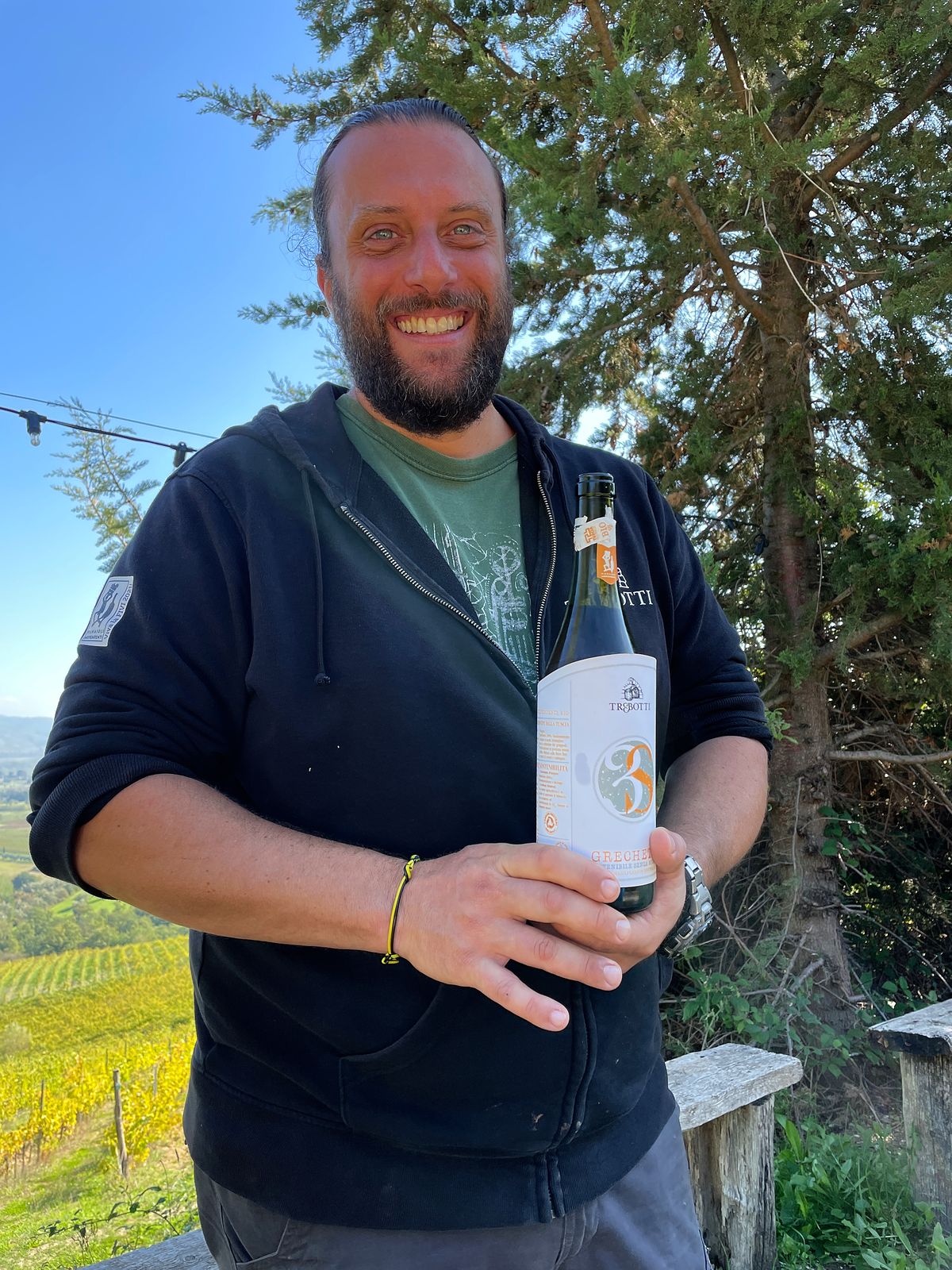 Federico, our Trebotti winery host and guide.
Federico, our Trebotti winery host and guide.
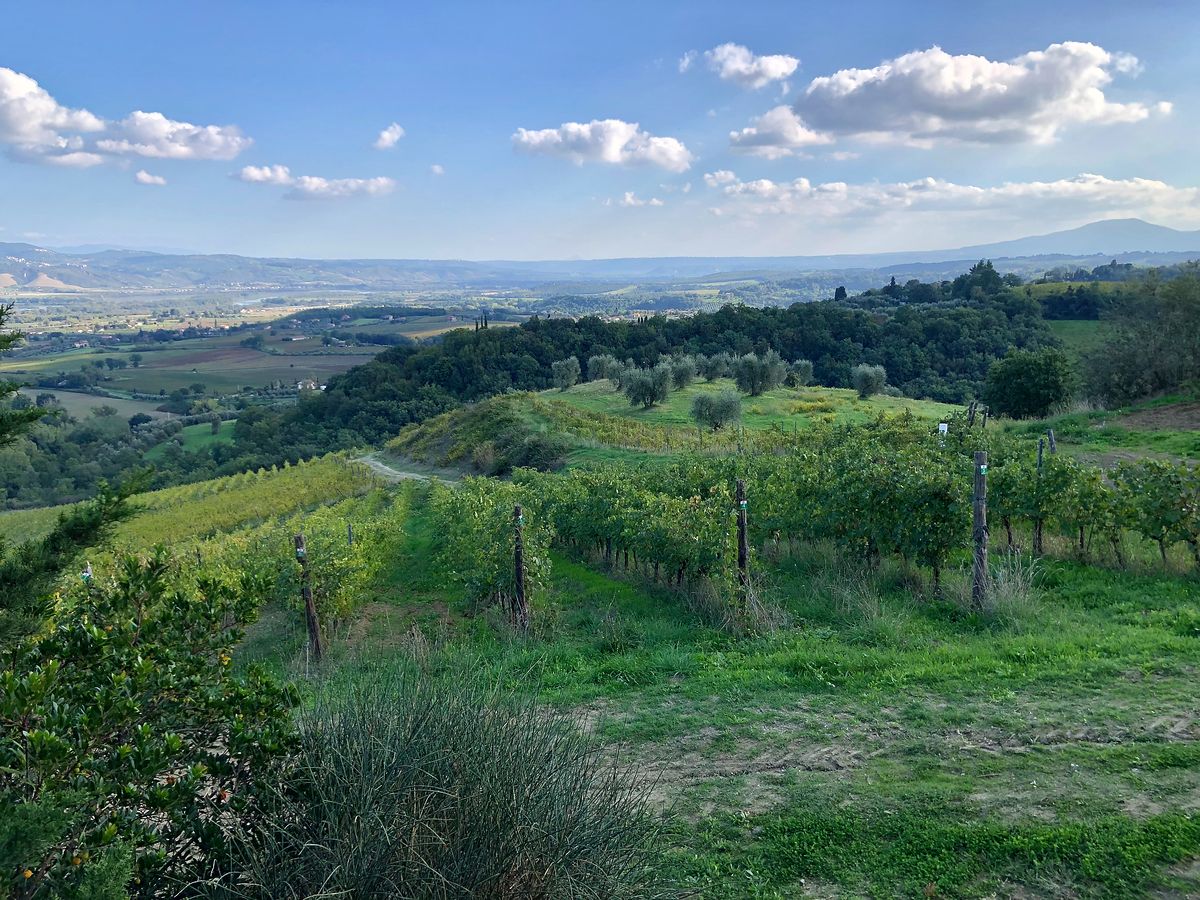 Trebotti wine farm overlooking the valley.
Trebotti wine farm overlooking the valley.
Our wine tasting featured five wines paired with homegrown produce and homemade bites, enjoyed overlooking the Trebotti vineyards below.? Sample the local Grechetto, a white wine varietal you'll likely become familiar with on your visit to the Lazio region. We sampled a rose and orange wine, both of which paired nicely with semi-dried tomato confit, crostini and local cured sausage.
Finally, we tasted two red wines, including our favorite Gocce Rosso made from Violone, the local Lazio name for the Montepulciano d'Abruzzo varietal. This paired with a 72-month aged caciocavallo cheese and homemade salted chocolate nocciola red wine crema proved an astonishing way to conclude a tasting.
La Serpara: Find the hidden sculpture garden
For over 25 years the artist Paul Wiedmer and his wife Jacqueline have invited artists to find inspiration in nature and to harness the creative spirit at their home-atelier tucked in the hills near the town of Civitella d'Agliano. Today, La Serpara is open for private visits.
You can enjoy a guided walk around sculpture gardens and bamboo forests dotted with modern art installations and take in the story of the site and the works that various artists-in-residence have created over the years.
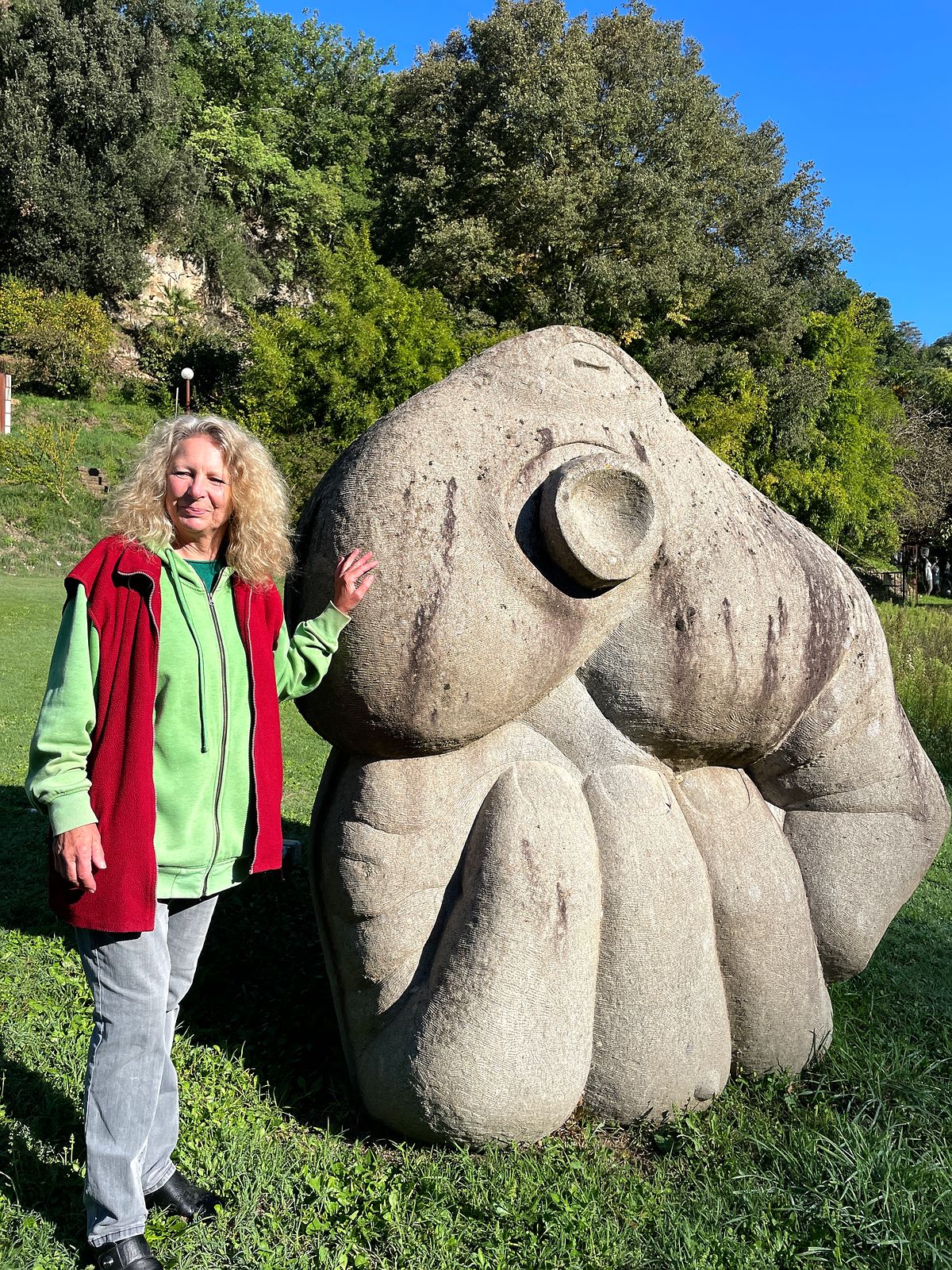 Jacqueline takes us around the garden to admire the sculptures.
Jacqueline takes us around the garden to admire the sculptures.
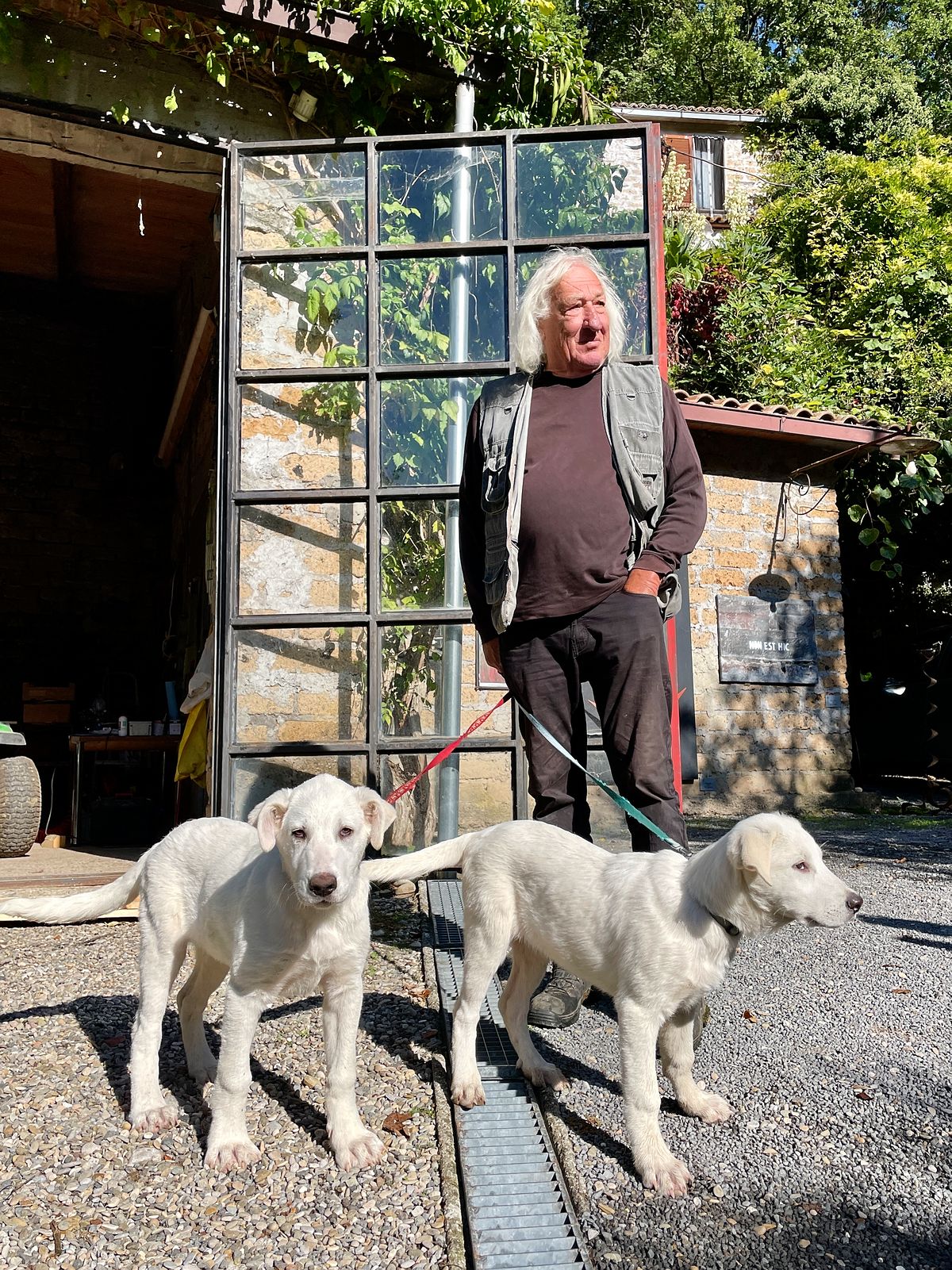 Paul Weidmer, artist and co-founder of La Serpara, with his puppy welcoming committee.
Paul Weidmer, artist and co-founder of La Serpara, with his puppy welcoming committee.
Civitella d'Agliano: craftsmen bicycles and castles
There seems to be no trade or service that couldn't be delivered on the back of a bicycle in early- to mid-20th century Italy. Knife sharpener, priest, portrait photographer, mattress cleaner, hairdresser, obstetrician. These are just a few of the professions, together with their customized, elaborately outfitted bicycles, that form the private collection at Il Mulino dei Mestieri (The Mill of Craftsmen) in Civitella d'Agliano.
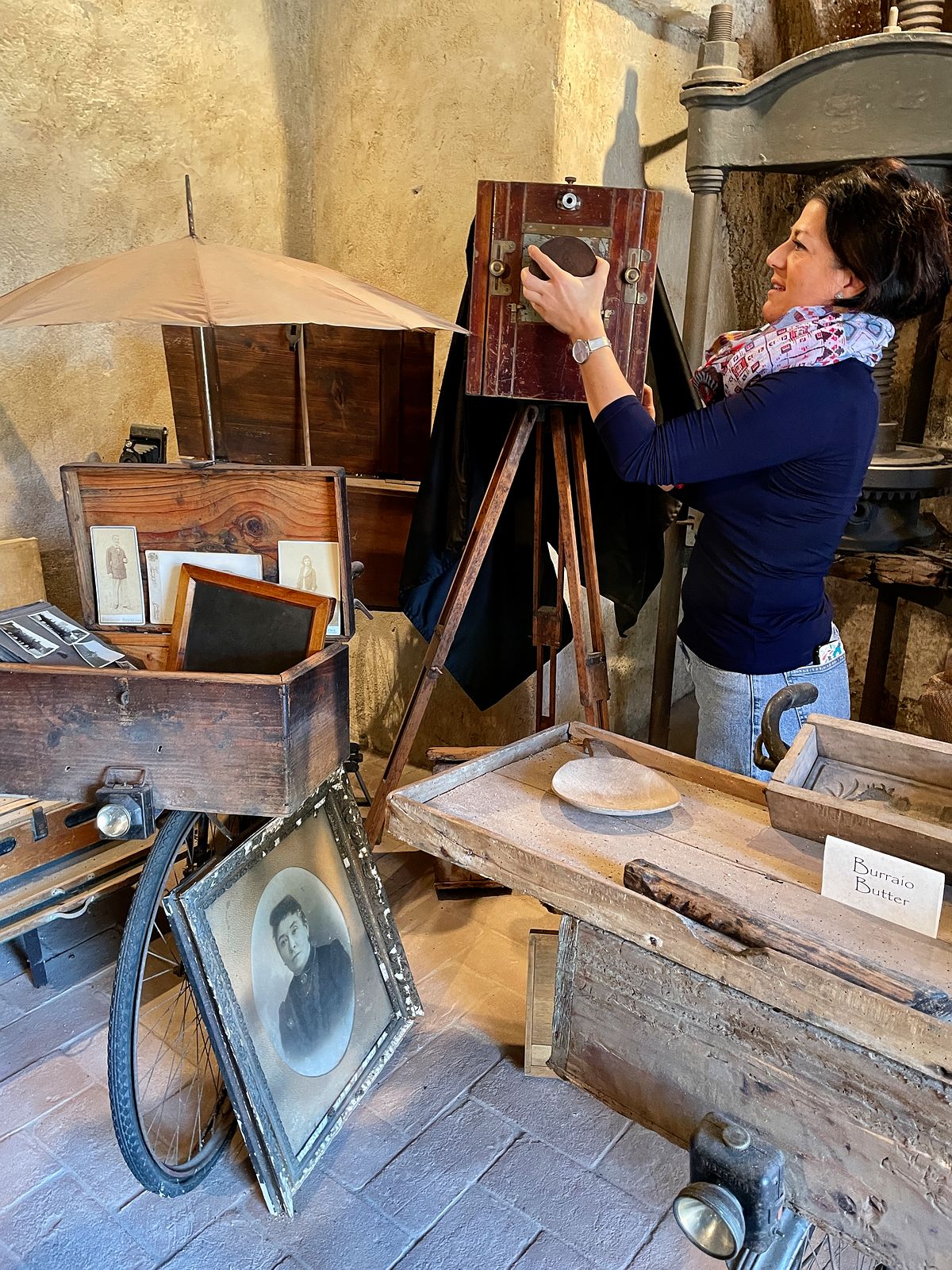 Yes, all of that photography processing equipment went on the bike.
Yes, all of that photography processing equipment went on the bike.
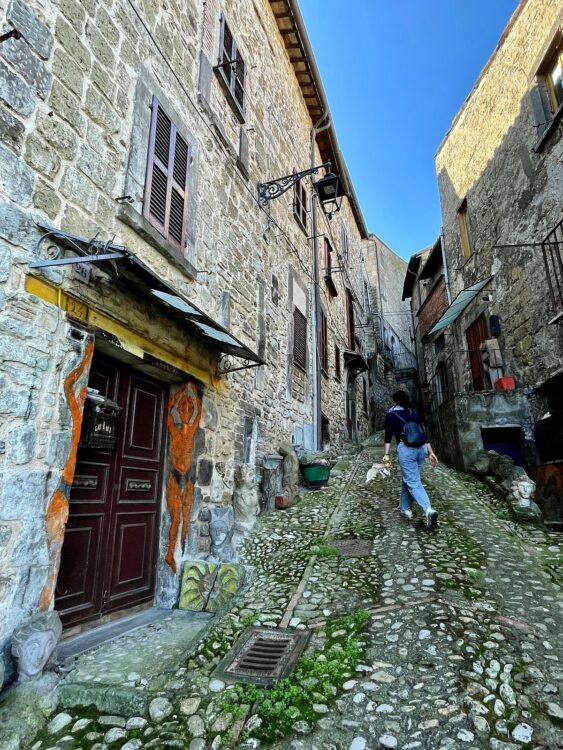 Streets so steep, Civitella d'Agliano.
Streets so steep, Civitella d'Agliano.
Alessia and her husband Daniele have spent over ten years collecting, repairing and lovingly restoring their collection of antique craftsmen bicycles. This snapshot of 20th century village trade history is now on display in a local mill. As Alessia showed us around and demonstrated kits of each bicycle, it was remarkable to see how every step, tool and feature of each service or trade was carefully integrated into bicycle construction.
If you are a bicycle-bound obstetrician, a baby's life depends on it!
Delivery services today seem to have nothing on the early 20th century blend of ingenuity and efficiency. And certainly nothing of the personality.
Celleno: Il Borgo Fantasma
The town of Celleno, known today as Il Borgo Fantasma (the “Ghost Town”), had been a vibrant, living hill town for over 1000 years until the mid-20th century when a string of earthquakes and landslides rendered it a dangerous place to live. However, each time the authorities tried to clear inhabitants from their homes and move them elsewhere, they returned. It was their home after all.
Eventually, in the 1950s, the authorities demolished most of the old town buildings. Hence, Celleno became a ghost town where only the ruins of buildings remain.
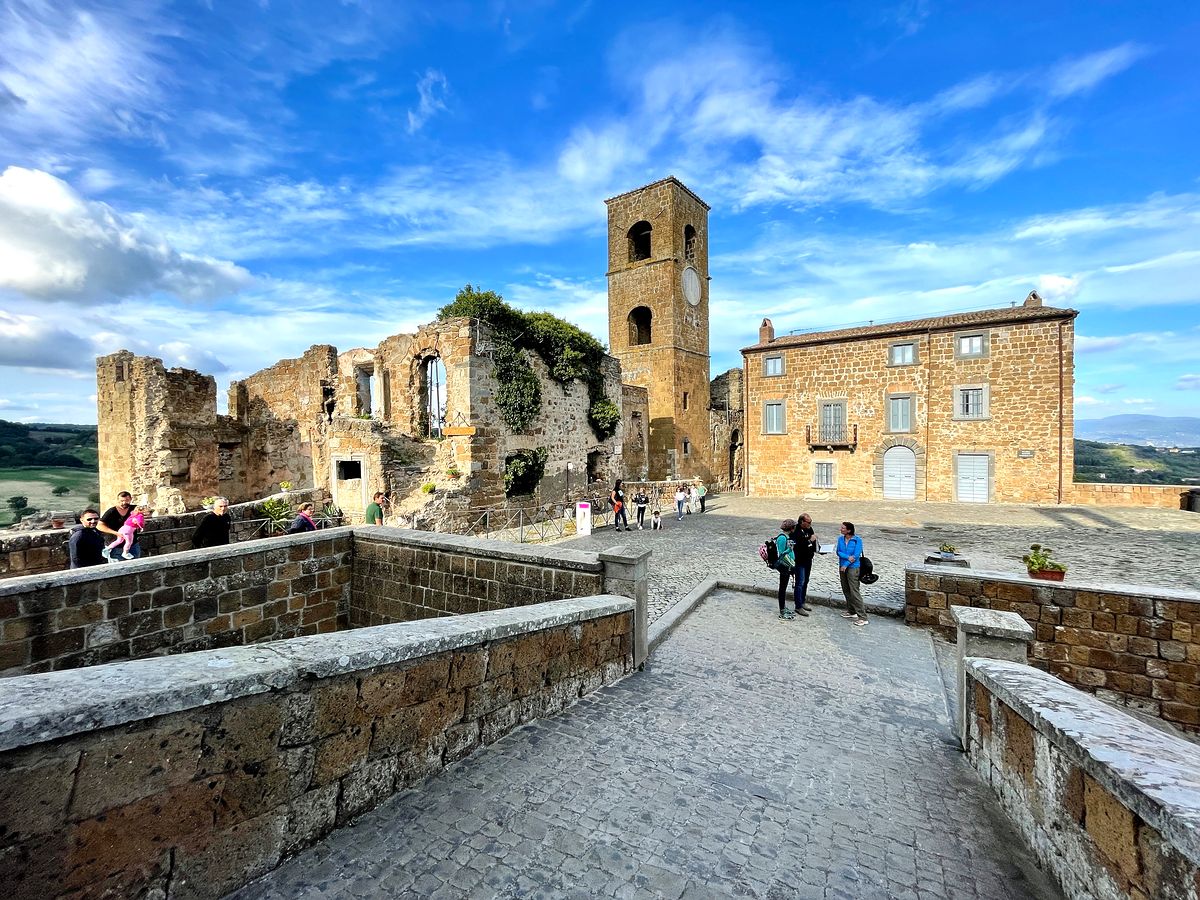 Like a movie set, the “Ghost Town” of Celleno.
Like a movie set, the “Ghost Town” of Celleno.
Some of the surviving medieval structures have recently been transformed into an open air museum and a series of historical exhibitions. One features a collection of 20th century sound and recording devices, while another antique and artifact exhibition is built around a multi-story medieval trash tunnel dating back 800 years. These “medieval trash heaps” as they are called are fascinating, not least of all because they give pause and make one wonder what story will one day be drawn from all the trash we currently generate.
Celleno, beautiful and intriguing, offers a fascinating story of of rescued history.
A taste of Tuscia, with a view at San Rocco Restaurant
San Rocco Restaurant, in the inhabited “new town” of Celleno, lies just outside the rampart walls of the ghost town and focuses on local Tuscian fare. Note that's not Tuscan fare, but Tuscian fare from the local region including hill towns like Celleno and the nearby city of Viterbo.
We were fortunate since our visit coincided with the porcini harvest. In-season porcini mushrooms were picked fresh from the forest off in the distance below our lunch terrace. Lunch also included rabbit stew, gnocchi in cime di rapa (broccoli greens) and a plate of stewed fagioli (beans). We opted to pair it all with a local Lazio Pinot Grigio called Satres from Le Lase vineyards. The orange hue in the glass? From 24 to 48 hours of contact with the skin of the grape.
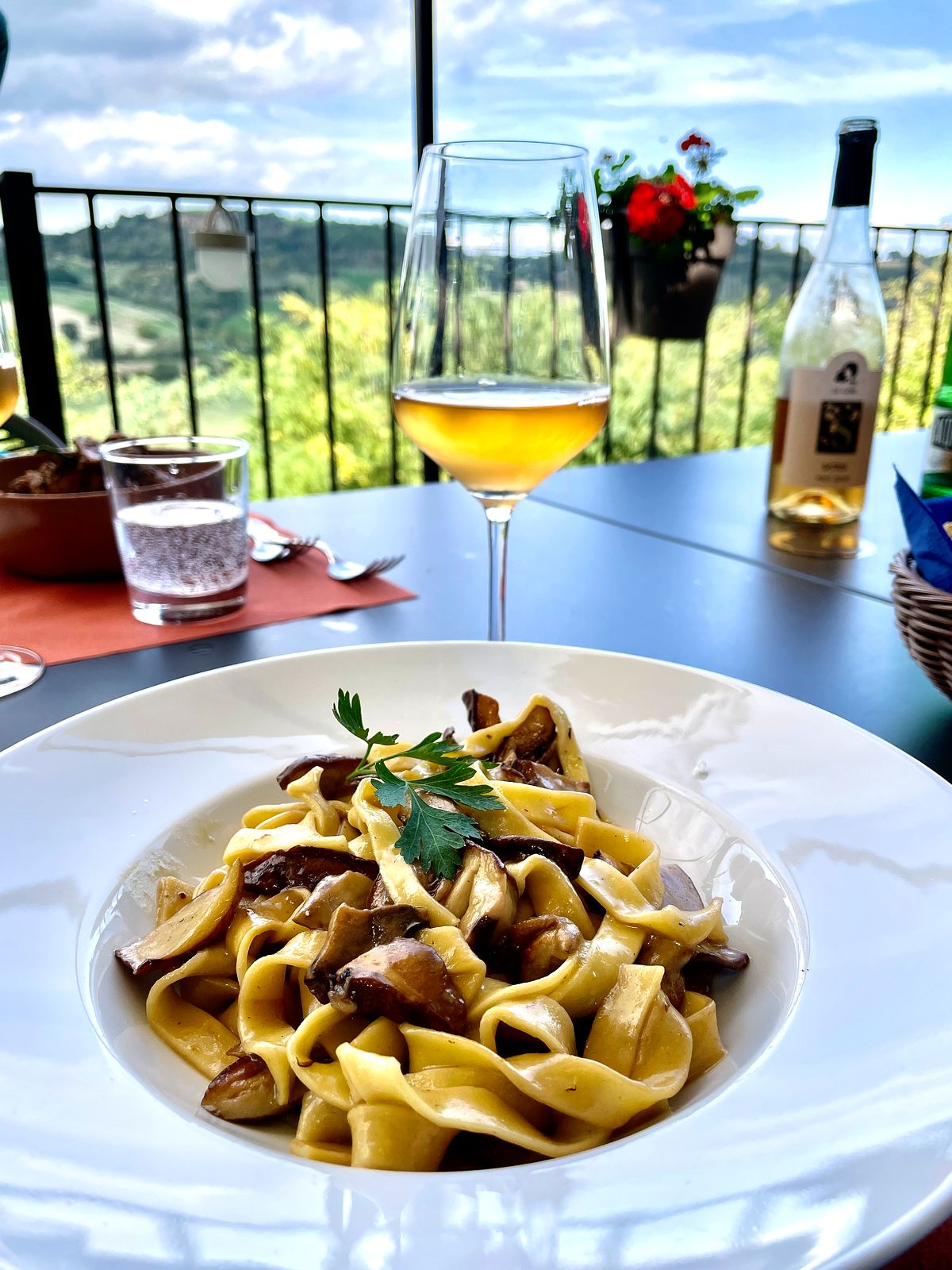 A visit timed with fresh porcini season. Delicious! San Rocco Restaurant, Celleno.
A visit timed with fresh porcini season. Delicious! San Rocco Restaurant, Celleno. Stay in the restored 18th century Villa Lais
One of the most memorable highlights of this itinerary was our 3-night stay at Villa Lais just outside the town of Sipicciano. Maddalena, the artist proprietor of Villa Lais, purchased this 18th century compound almost ten years ago and has lovingly renovated it over the ensuing years.
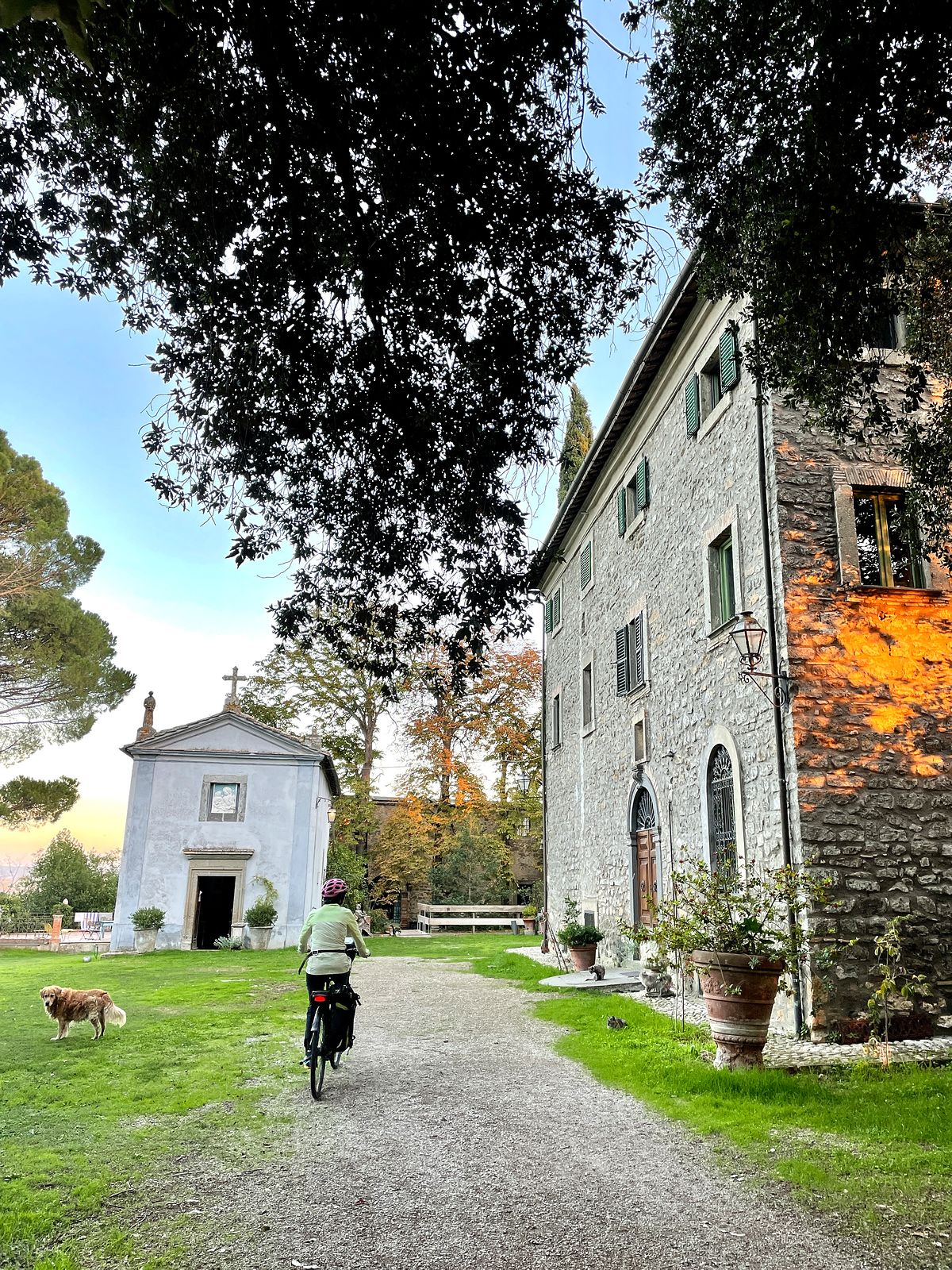 Returning “home” to Villa Lais after a day of exploring Tuscia.
Returning “home” to Villa Lais after a day of exploring Tuscia.
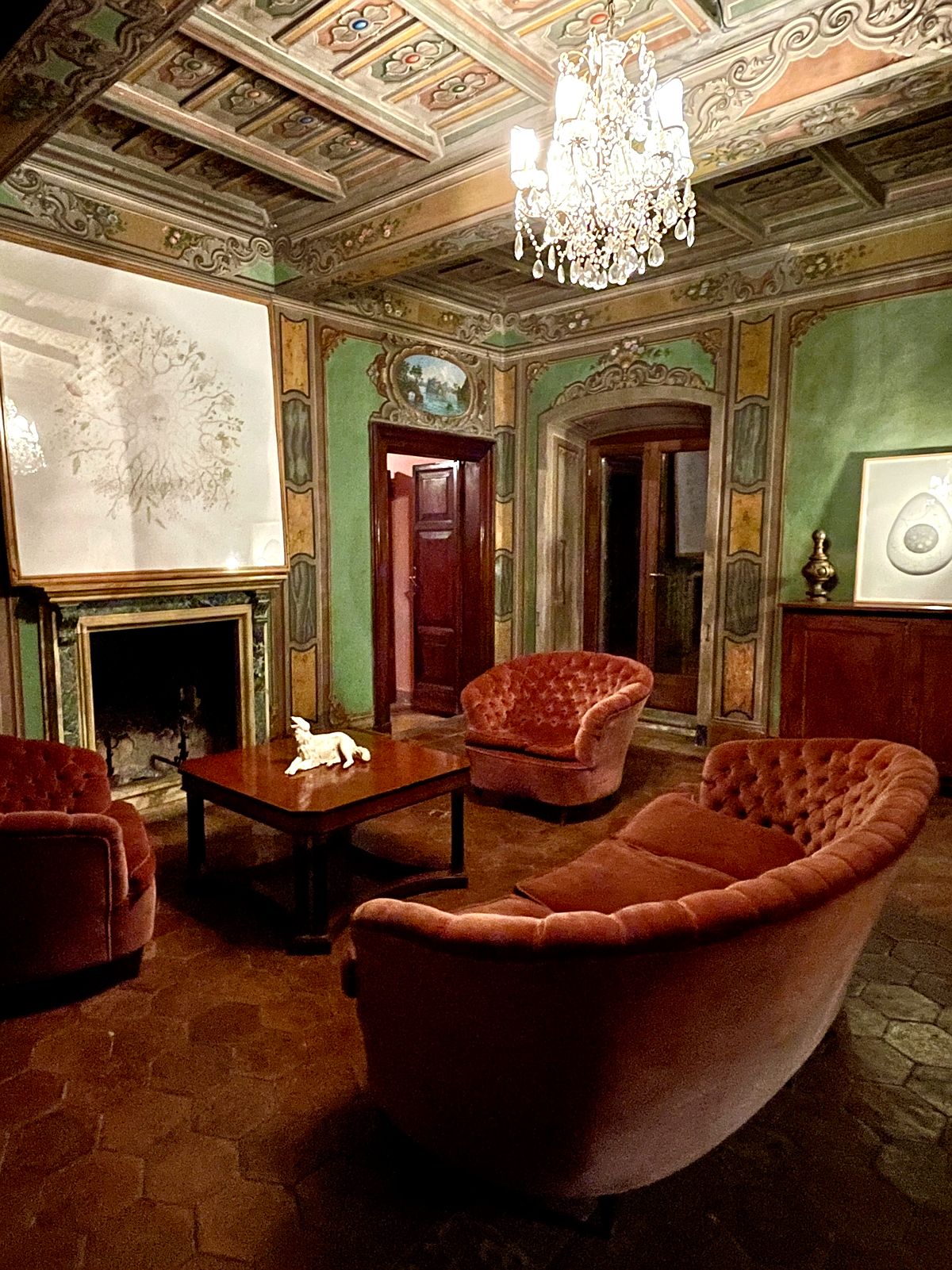 Design and decor at Villa Lais.
Design and decor at Villa Lais.
 A warm welcome from Caino as one of Villa Lais' 10 cats conducts surveillance.
A warm welcome from Caino as one of Villa Lais' 10 cats conducts surveillance.
Ceilings and walls of inlaid wood illustrated in muted yet dazzling color mesmerize with detail, line and story. The tableau is rich yet not gratuitously busy or overdone. Maddalena's careful eye for design shows in everything, from the furniture to the wine glasses used at dinner, to create a feeling of living history and continuity to the villa's past that feels in no way contrived.
Another characteristic that makes this place feel like home are the four dogs and ten cats who are always ready to greet you when you return from a day of countryside exploration.
Sacro Bosco, the 16th Century “Park of the Monsters”
Sacro Bosco (“Sacred Forest”), also affectionately known as Park of the Monsters, is more firmly on the tourist path than most other destinations we visited in Lazio. But we kind of understand why. The park and its sculptures were commissioned in the mid-16th century by Prince Pier Francesco Orsini as a way to express his grief due both to the untimely death of his wife and the weight of the brutality he had witnessed in war.
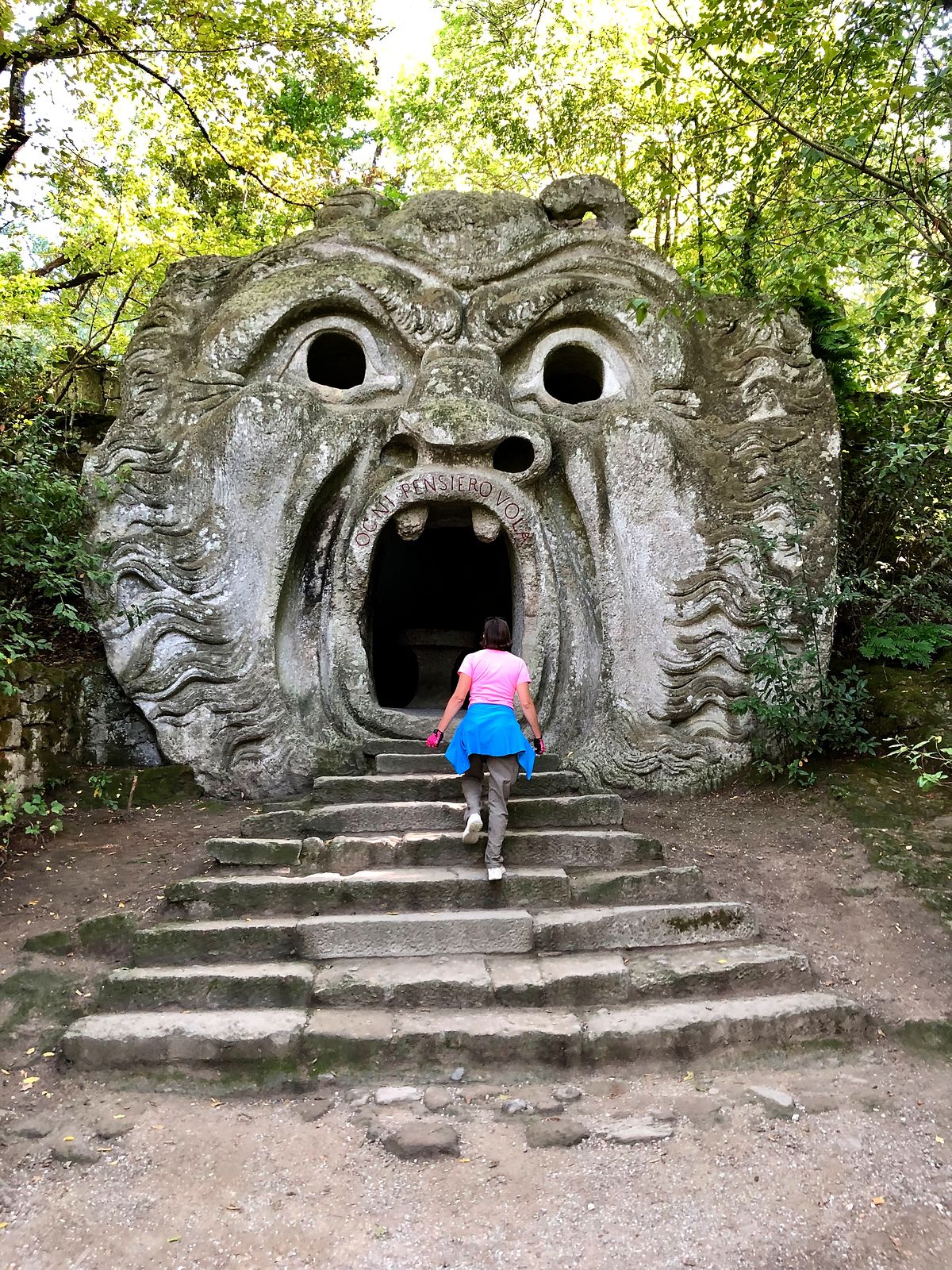 This one was probably for war grief. Sacro Bosco, Bomarzo.
This one was probably for war grief. Sacro Bosco, Bomarzo.Featuring a collection of large stone sculptures depicting fantastic and often disturbing creatures all scattered about in a forest just outside the hill town of Bomarzo, the park was a bit ahead of its time in its vision and anticipation of the need for exhausting one's grief. Despite the fairly steep price of individual admission (13€) and the park's undeniable commercial feel, it might still be worth a look.
2. Tevere-Farfa Reserve and Nazzano: nature, hill towns and art
Our exploration of Lazio continued further along the Tiber River in and around the Tevere-Farfa Natural Reserve. This is the place where the Tiber River environment takes center stage in the experience. Landscapes are green and the pace is reflective, despite the area only being an hour northeast of Rome by train.
Hill towns feature again, but they serve as the backdrop for natural surroundings like swimming wild boars, as well as moments of contemporary culture and artistic flourish, and a surprising lesson in modern history.
Canoeing the Tiber River
The bends of the Tiber River in open green space define the Tevere-Farfa Natural Reserve. Landscape is defined by texture, including hillsides of exposed volcanic tufa rock. Castles seem to keep watch atop the nearby hills overlooking the river valley. Wildlife make their way about. For the first time, we encountered wild boars swimming, making their way from one side of the river to the other.
When we did our paddle, we encountered grey herons and egrets, and various birds pausing as they make their way southward.
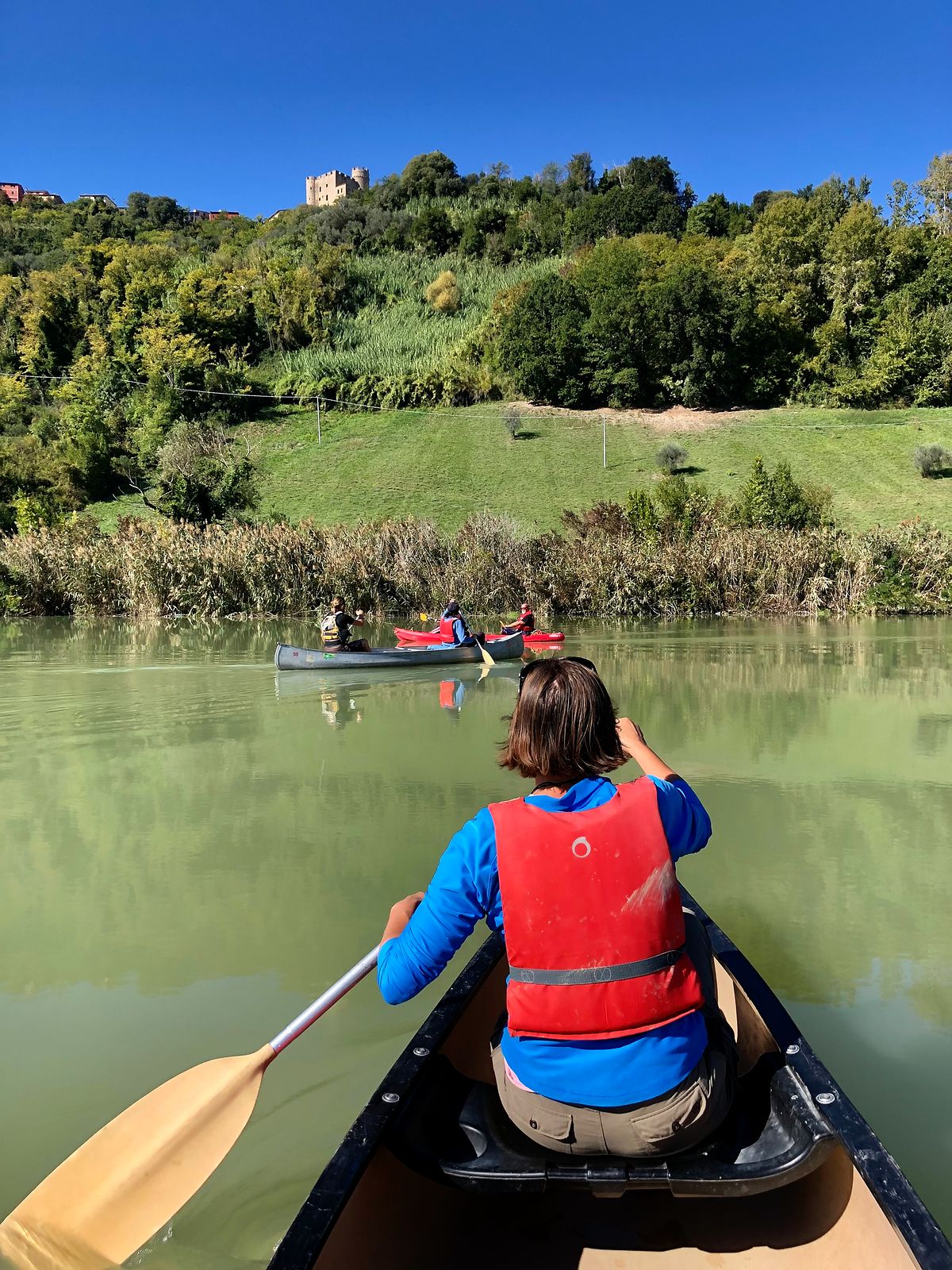 Canoeing the Tiber River in Tevere-Farfa Natural Reserve. Nazzano Castle up ahead.
Canoeing the Tiber River in Tevere-Farfa Natural Reserve. Nazzano Castle up ahead. Eat farm-to-table at La Fattoria Campo di Contra
As we lounged and noshed farm-to-table with Mauro, founder of La Fattoria Didattica Campo di Contra, we found our table refreshed multiple times with simple dishes fashioned from produce fresh from his organic garden and goods sourced from nearby farms and producers.
Over conversation about life in the region, we enjoyed a range of small plate treats like zucchini flower fritters sided with honey made by bees who snack on local resin, antipasto locale, grilled melanzane (eggplant) and peppers, and fresh bean salad. And Mauro served all of it with his rather quaffable homemade wine.
With our meal as the object lesson, we could feel the vision Mauro has for his land and for helping to connect visitors to nature.
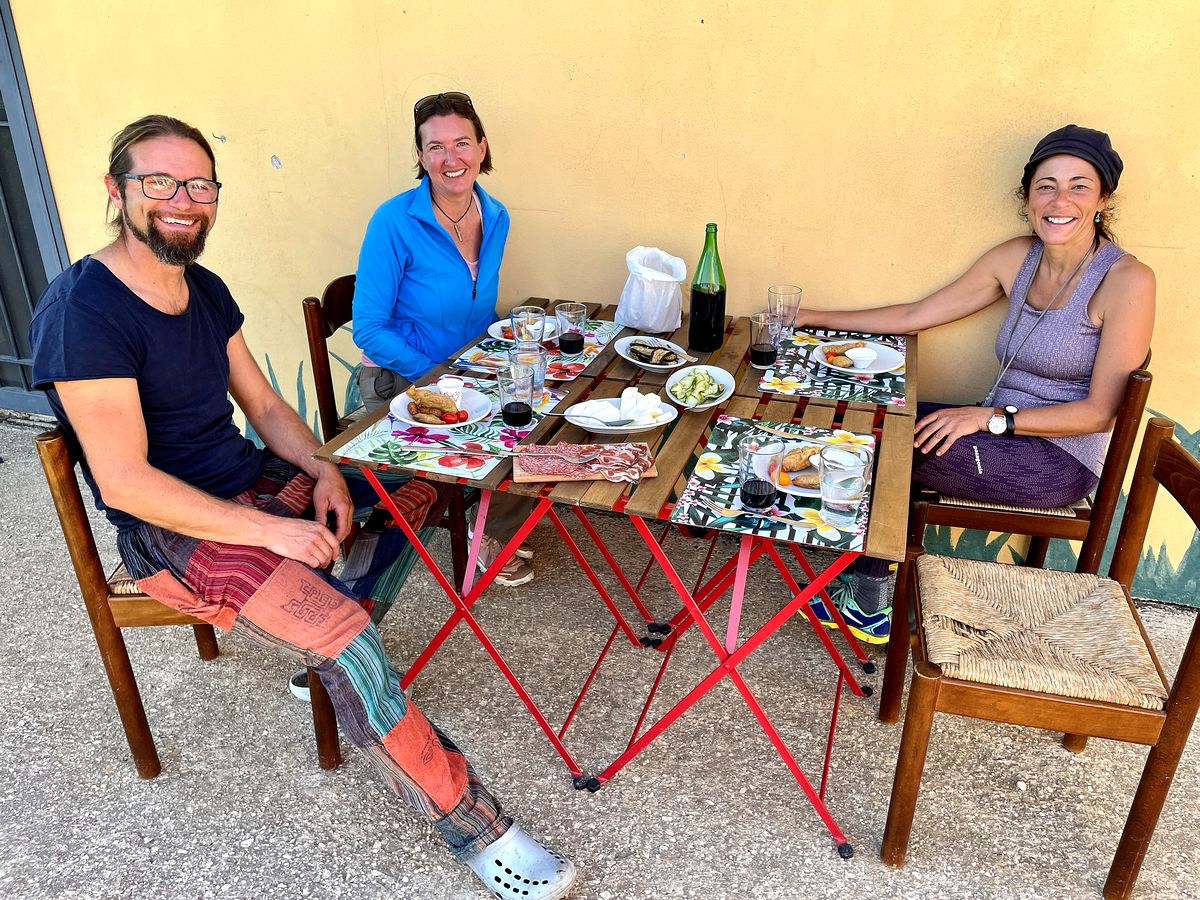 A post-canoe lunch at La Fattoria Campo di Contra.
A post-canoe lunch at La Fattoria Campo di Contra.
Medieval hill towns and castles to explore
Hill towns featured again in our travels across the Tiber River valley, including one of our visual favorites, Nazzano. It's the one you'll see from below in the Tevere-Farfa Nature Reserve. Historically, we imagined it high up and cliffside in order for its minders to eye the Tiber River below as it flowed with goods into Rome.
As we dreamily perused listings posted inside windows of real estate agents in Nazzano we wondered what it would be like to set up shop, restore one of these buildings and actually live here.
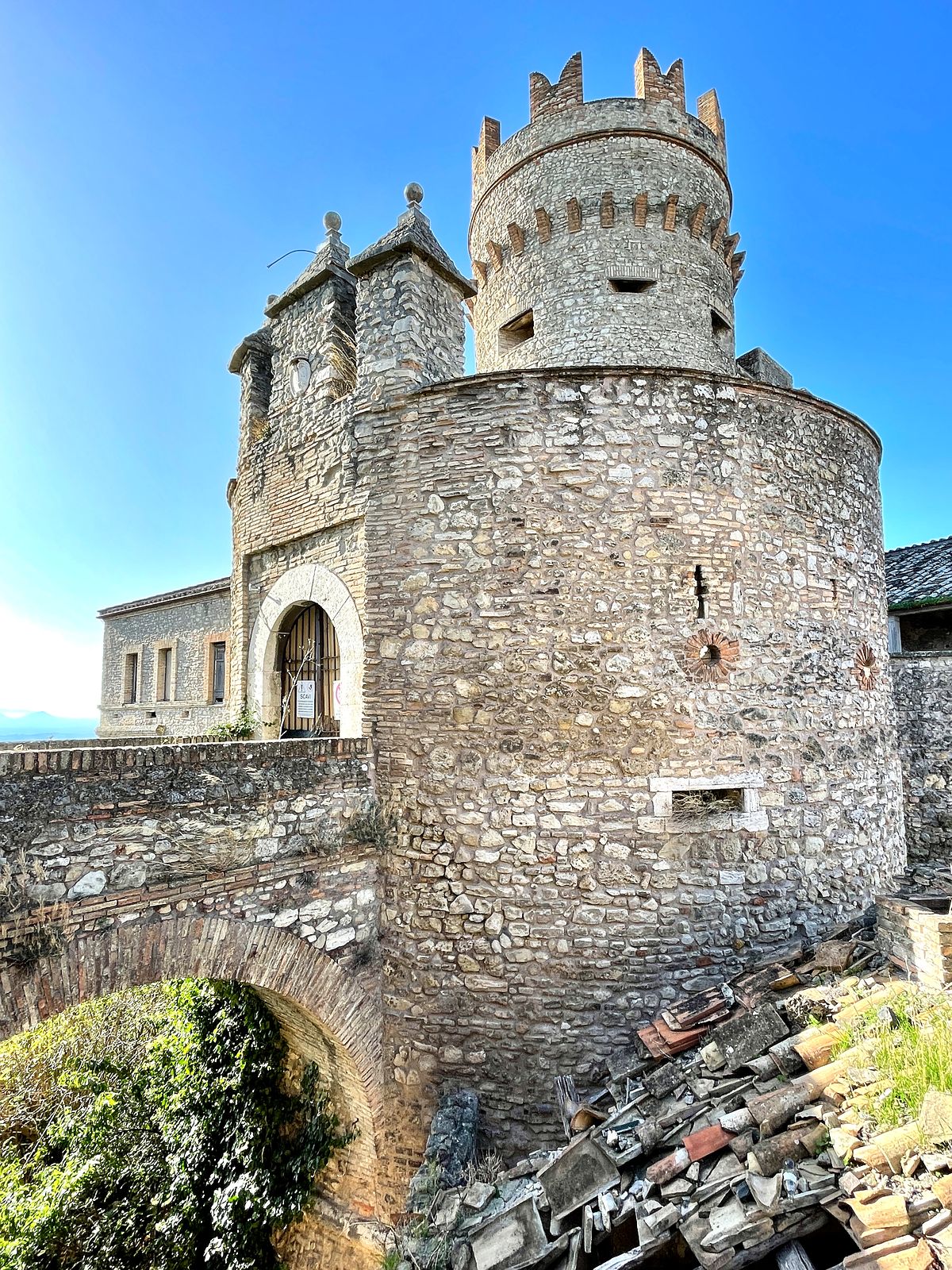 There be castles in Lazio, too. This one in Nazzano.
There be castles in Lazio, too. This one in Nazzano.
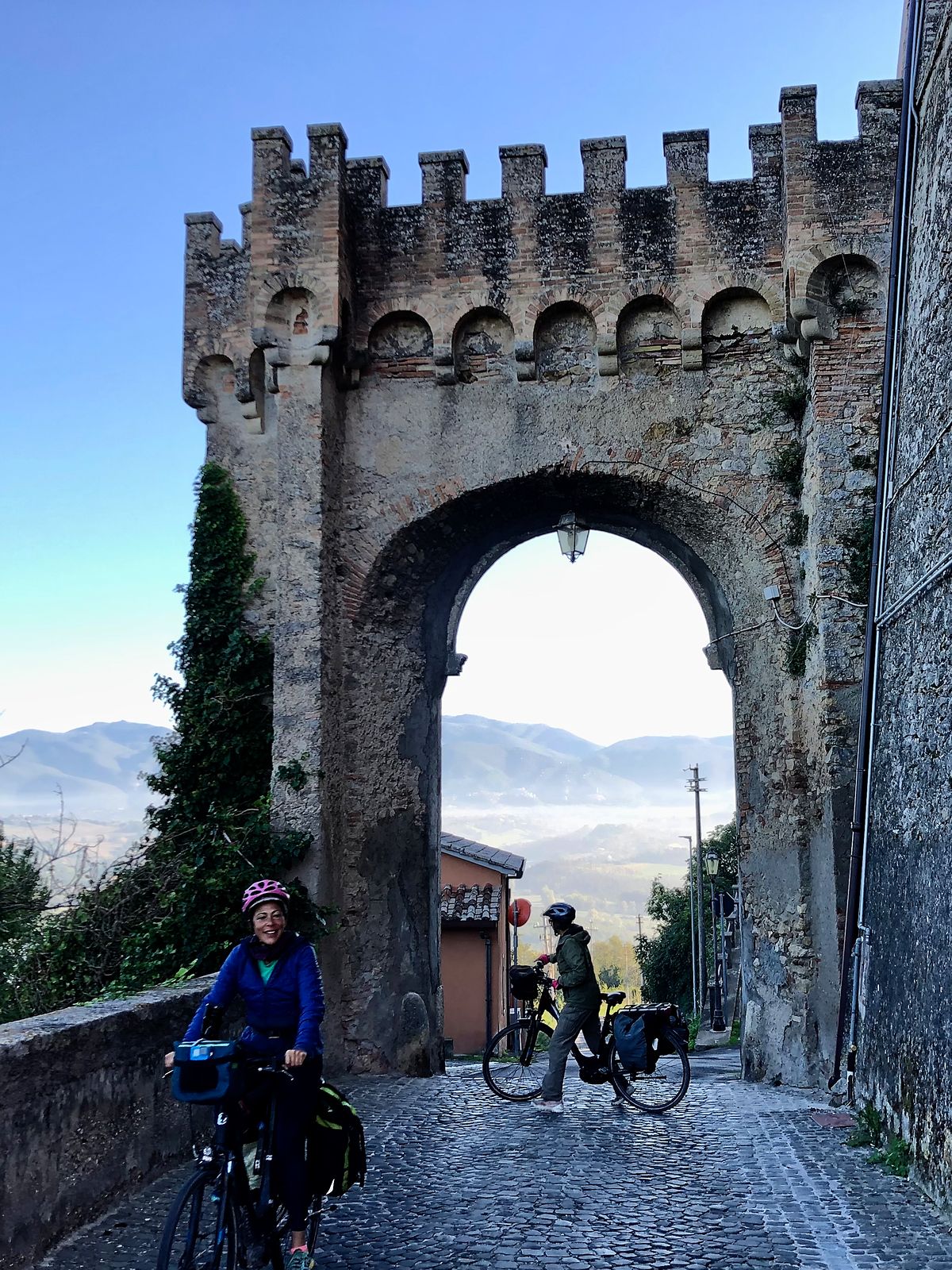 Grand entry by e-bike to the hill town of Filacciano.
Grand entry by e-bike to the hill town of Filacciano.
In other hill town stops, we enjoyed beer and snacks in a piazza (and got invited to lunch), took espresso breaks with locals enjoying the morning sun and did things like snack-slurp suppli di telefono, a warm croquette so-called because its mozzarella is so oozy it stretches like telephone wire.
Hike and cycle the trails of Tevere-Farfa Natural Reserve
Tevere-Farfa Natural Reserve is the first protected area in Lazio Region. When we first entered the park, we found ourselves clearly in the thick of nature. The sun was low and peeked through the trees, casting light and shadows on the more curious members of the local boar families lurking about.
Between boat rides and canoe trips, we took gentle strolls and and cycled much of the trail that winds itself around and through the bends in the Tiber.
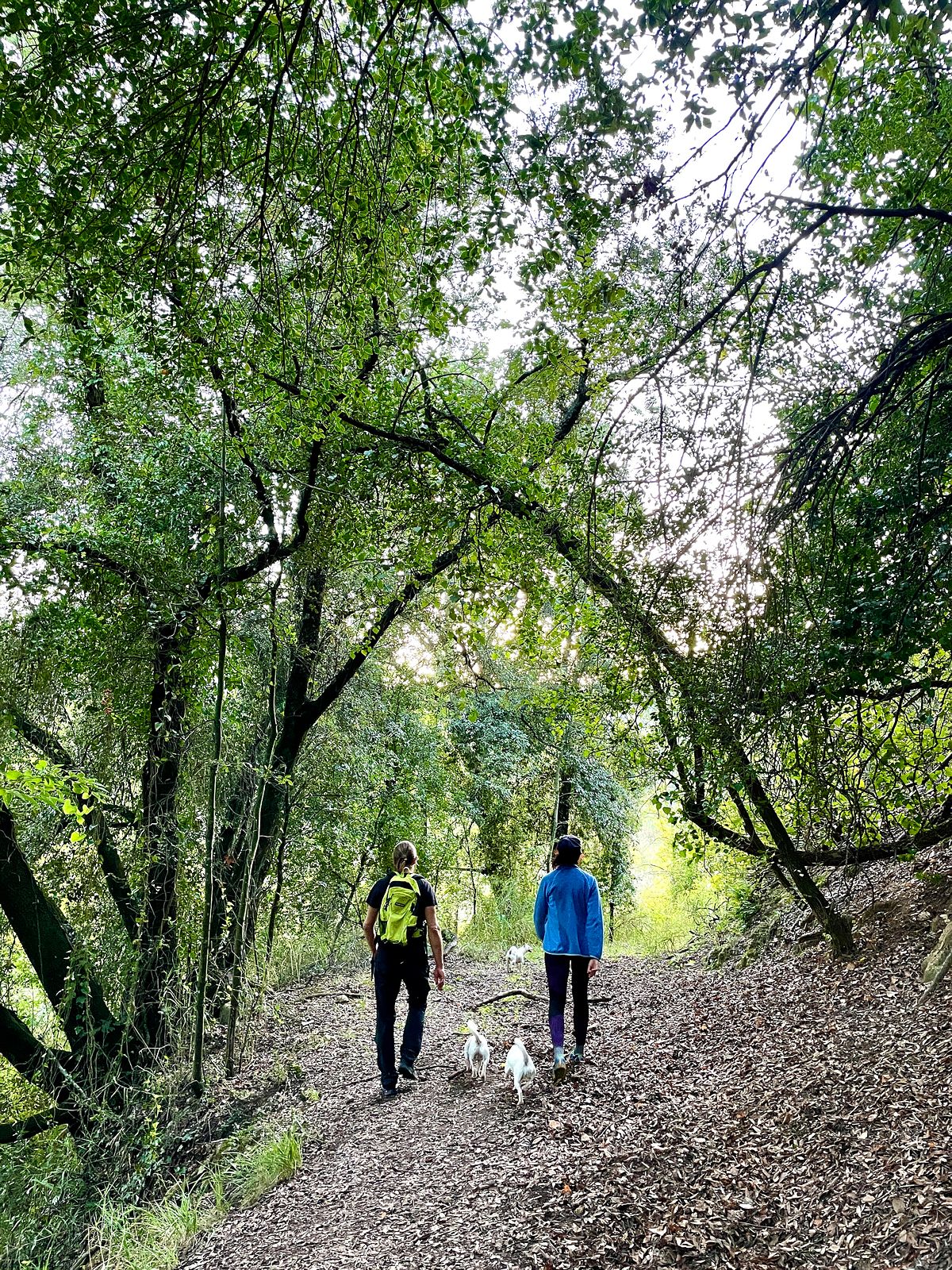 HIking in Tevere-Farfa Natural Reserve, Lazio
HIking in Tevere-Farfa Natural Reserve, Lazio
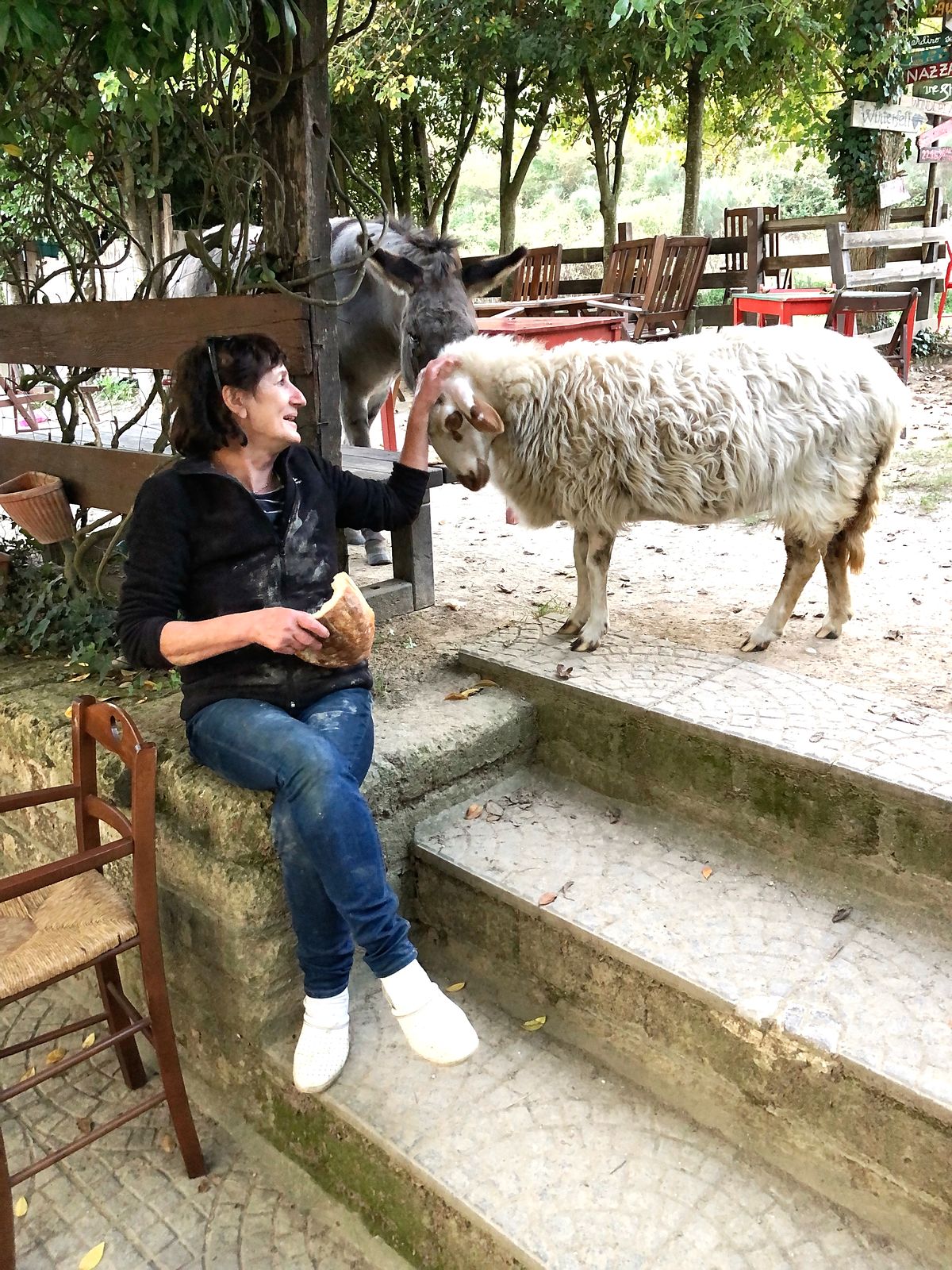 A few of the characters at Ecoturismo Tevere Farfa.
A few of the characters at Ecoturismo Tevere Farfa.
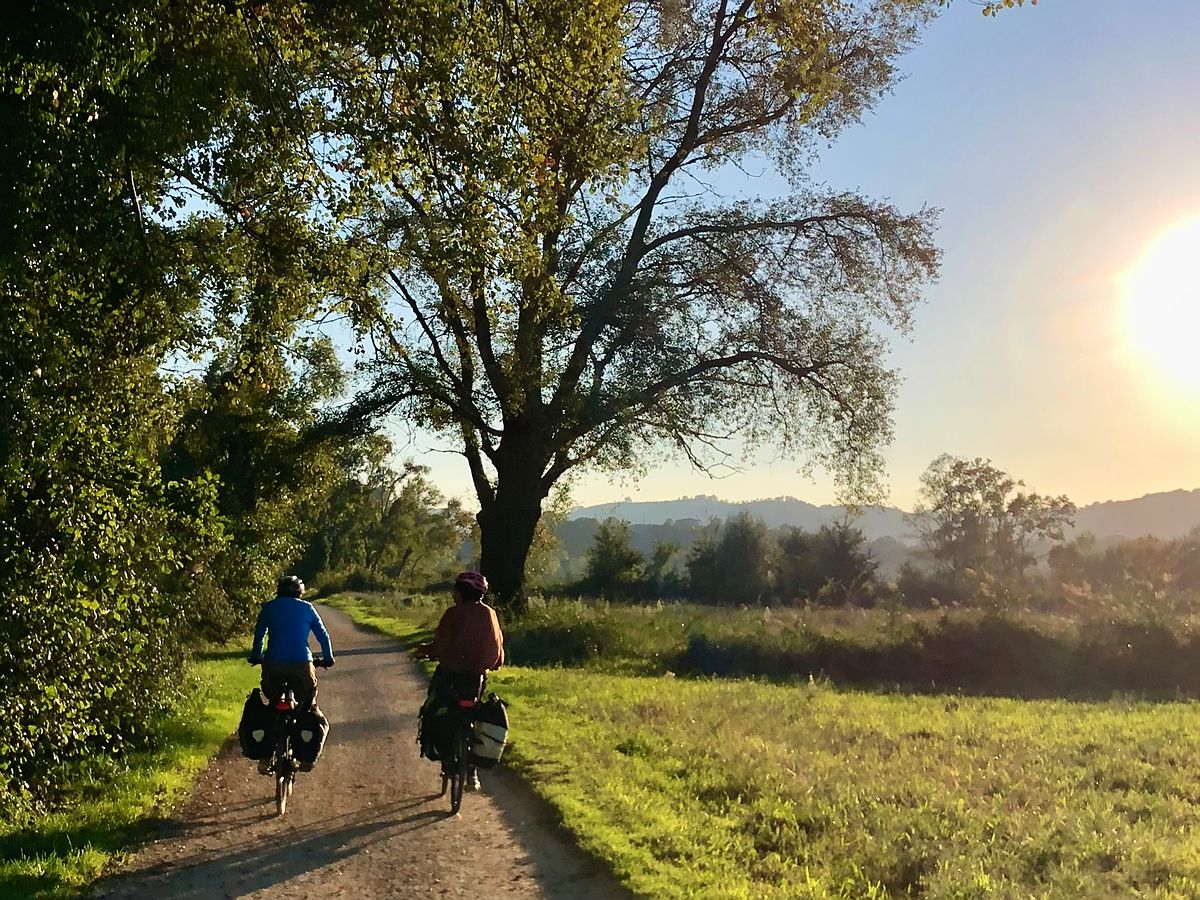 The cycling trails of Tevere-Farfa Natural Reserve in late afternoon.
The cycling trails of Tevere-Farfa Natural Reserve in late afternoon.
Ecoturismo Tevere Farfa, built on the site of the old organic farm cooperative, is the only accommodation in the park itself and served as our base. Home to a curious cast of characters including a donkey and a sheep who enjoys giving head butts, it functions also as an educational and community gathering center.
Ponzano Romano: Enjoy a conversation with a local artist
Though most of Michele Longo's working years were spent in Rome directing films and mixing it up in cafes with the likes of Pasolini, he now focuses his time painting and creating mixed media art in his apartment studio in the hill town of Ponzano Romano. Surrounded by plants and fruit trees on his sunny veranda, we enjoyed a conversation with him over Cornettino di Ponzano Romano (a savory crisp croissant twist dashed with anise, extra virgin olive oil and glazed just slightly sweet) and demi-tasses of espresso.
Longo's passion is palpable, as is his concern for what he sees as the deterioration of societal elements that support the development of creativity. We appreciated his pithy wisdom and spirit at 82-years young. We also discovered his secret to “creative fermentation” along the way. Hint: it's not about virtual interaction.
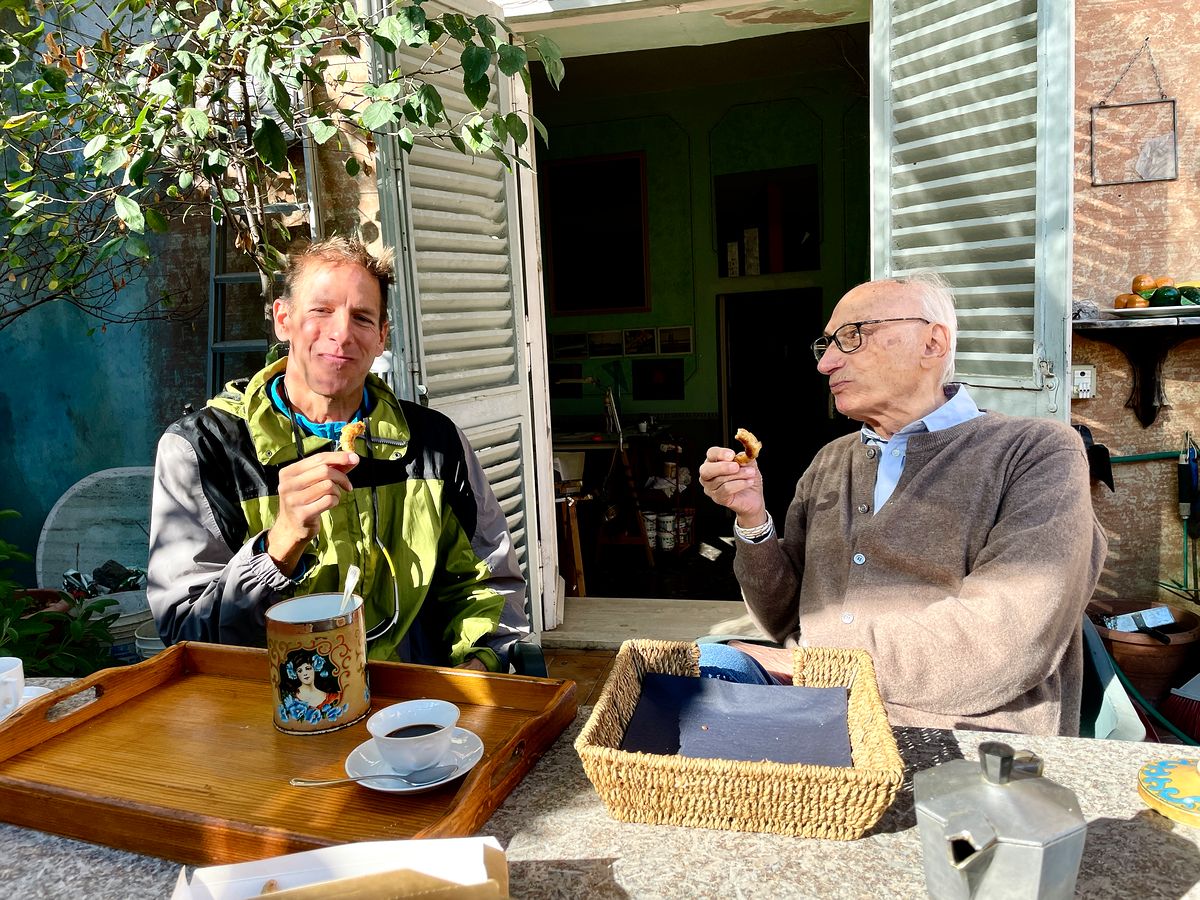 Conversation with an artist, Lazio edition.
Conversation with an artist, Lazio edition.Ponzano Romano is also known for its contemporary art museum, which was unfortunately closed at the time of our visit due to a change in exhibitions. However, if you take note of Longo's observation that Ponzano Romano is a more creative city than Rome, the museum is likely worth a look.
Bunker Soratte: Go deep in the WWII and Cold War tunnels
Just when you think you've seen it all in terms of WWII and 20th century military history, you walk into this place and one jaw-drop follows another as history bends the mind again.
Marvel at the scale of Bunker Soratte, Mussolini’s mega-bunker tunnel complex atop Mount Soratte and near the town of Sant'Oreste. Apparently sensing the winds of war, Mussolini ordered it carved into the mountains by Italian engineers. After its construction from 1937 to 1939, and due to Il Duce’s loose hubristic lips, the bunker was squatted by Nazi Germany thereafter and run by Field Marshal Albert Kesselring as the Supreme Command of the South.
Later during the Cold War, the four kilometer tunnel network would become a nuclear fallout shelter for officials in the Italian government.
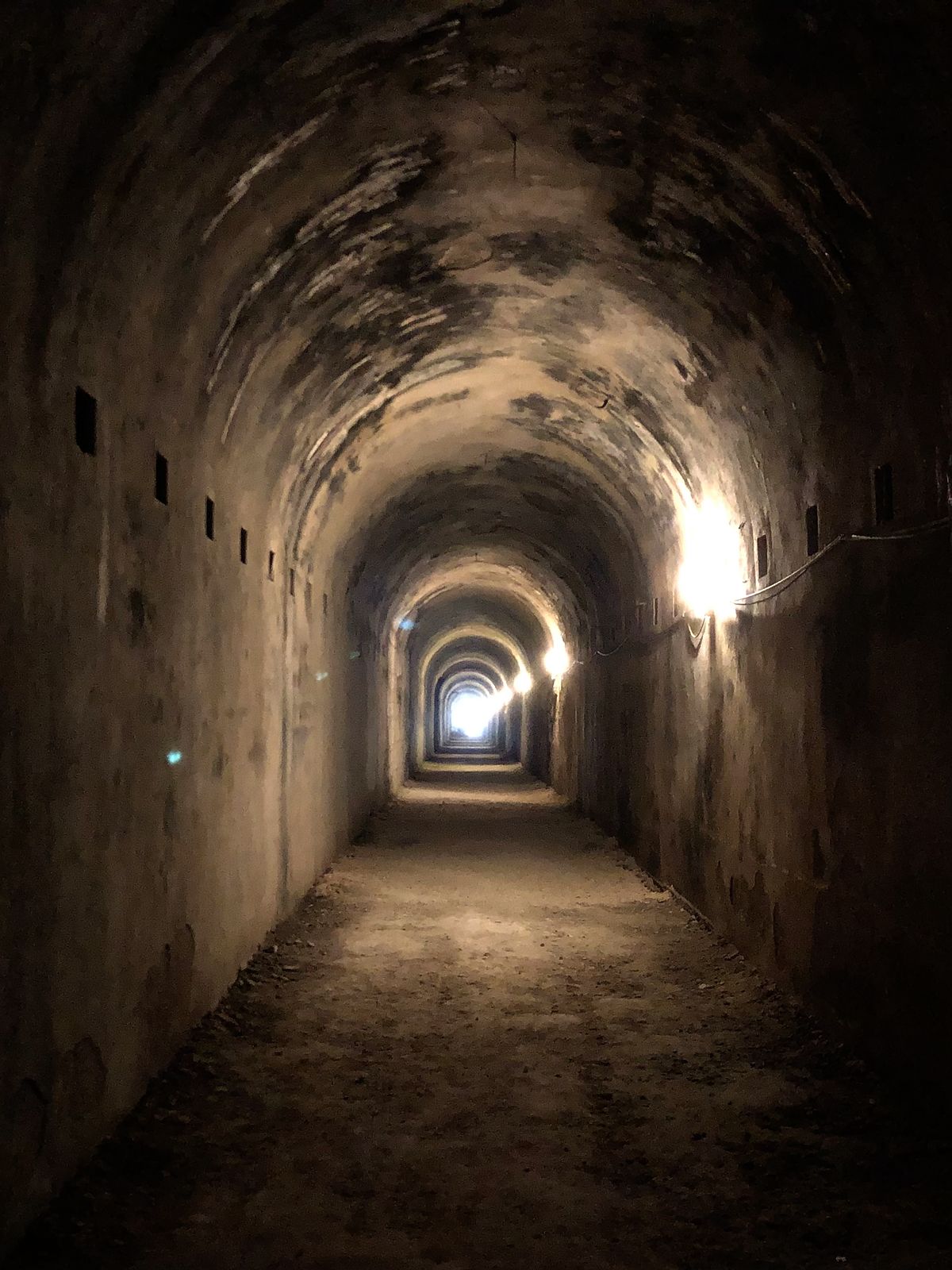 One of the long, deep tunnels of Bunker Soratte.
One of the long, deep tunnels of Bunker Soratte.
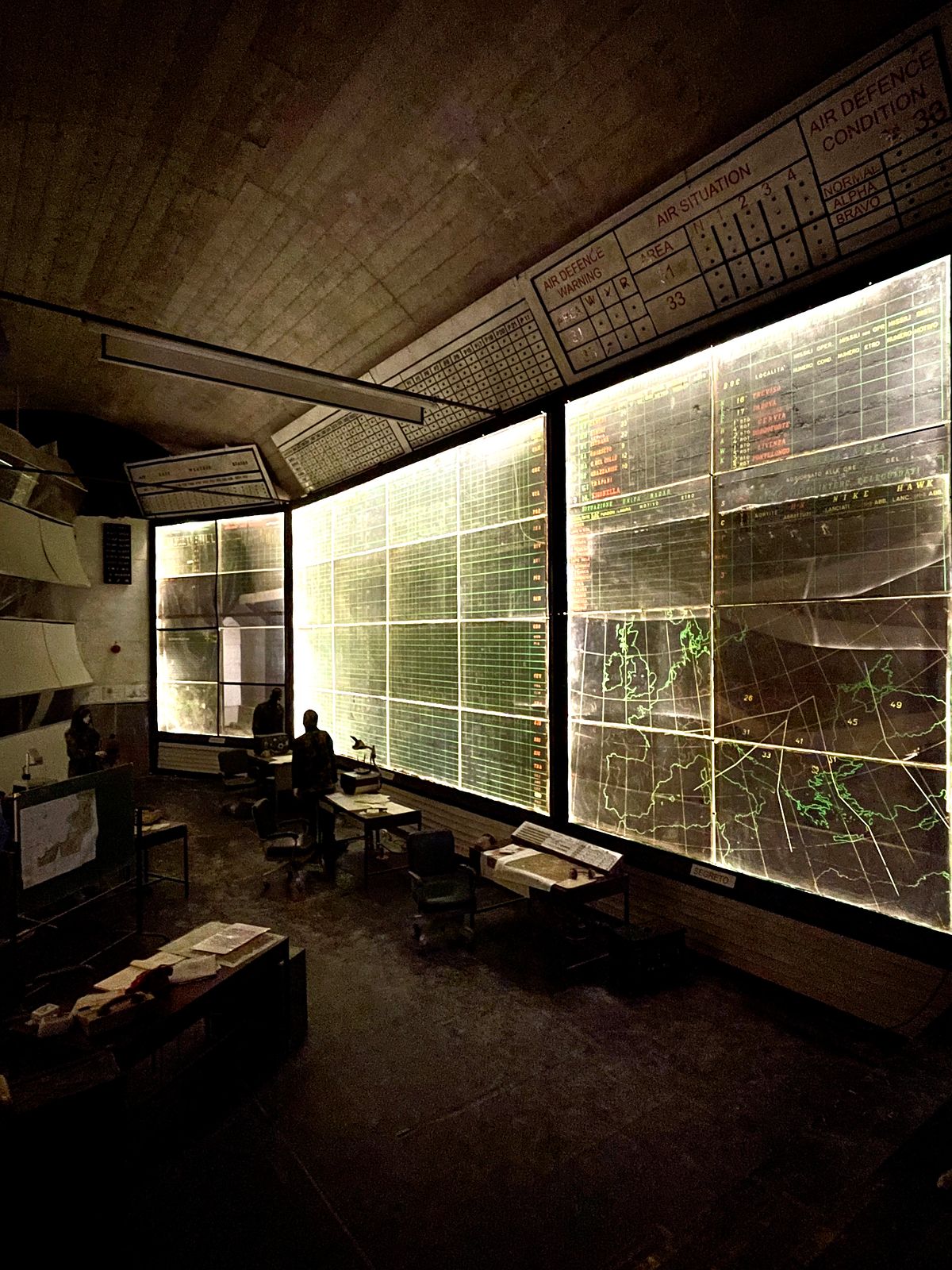 Bunker Soratte's Cold War history comes through in the NATO situation room.
Bunker Soratte's Cold War history comes through in the NATO situation room.
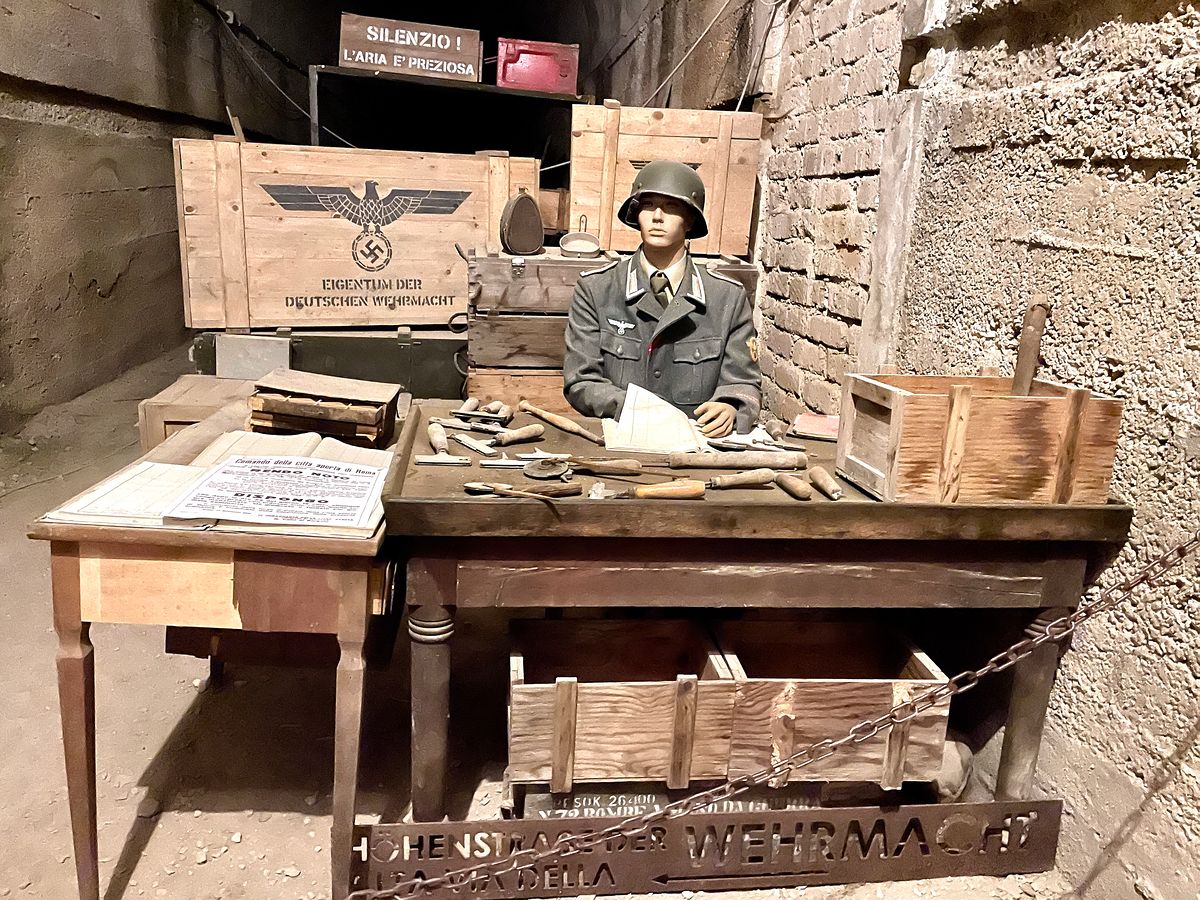 Exhibition illustrating the Nazi German occupation of Bunker Soratte during World War II.
Exhibition illustrating the Nazi German occupation of Bunker Soratte during World War II.
Site lore makes the place even more intriguing. One story tells of the allied bombing of the bunker (that deliberately spared the nearby town) with the help of a local engineer who communicated intelligence and guidance signals via a transmitter hidden in a birdcage. (Does that make him “the bird man” of Sant'Oreste?) And the lost, stolen Nazi gold? That one begs a miniseries.
The whole thing is pretty sobering too, once you overcome the fascination. Some reflective time out for an espresso or the drink of your choice should follow in the friendly little town of Sant'Oreste nearby.
Fondazione Serpone: art, nature and a surprising chapel
The sculpture garden and outdoor art installations at Fondazione Serpone in Torrita Tiberina are made available by way of a private family collection open to the public (by appointment). Each of its artist-donated pieces is carefully considered and positioned throughout the grounds of the hillside property.
Together, the pieces delight in playful, subtle ways. The subtlety ends, rather deliberately, upon opening the door to the chapel installation executed by Austrian philosopher-artist Hermann Nitsch. What might be considered the centerpiece of the property and its installations, the chapel's interior offers a surprising and challenging interpretation of the spiritual. And the chapel is blessed by the local bishop!
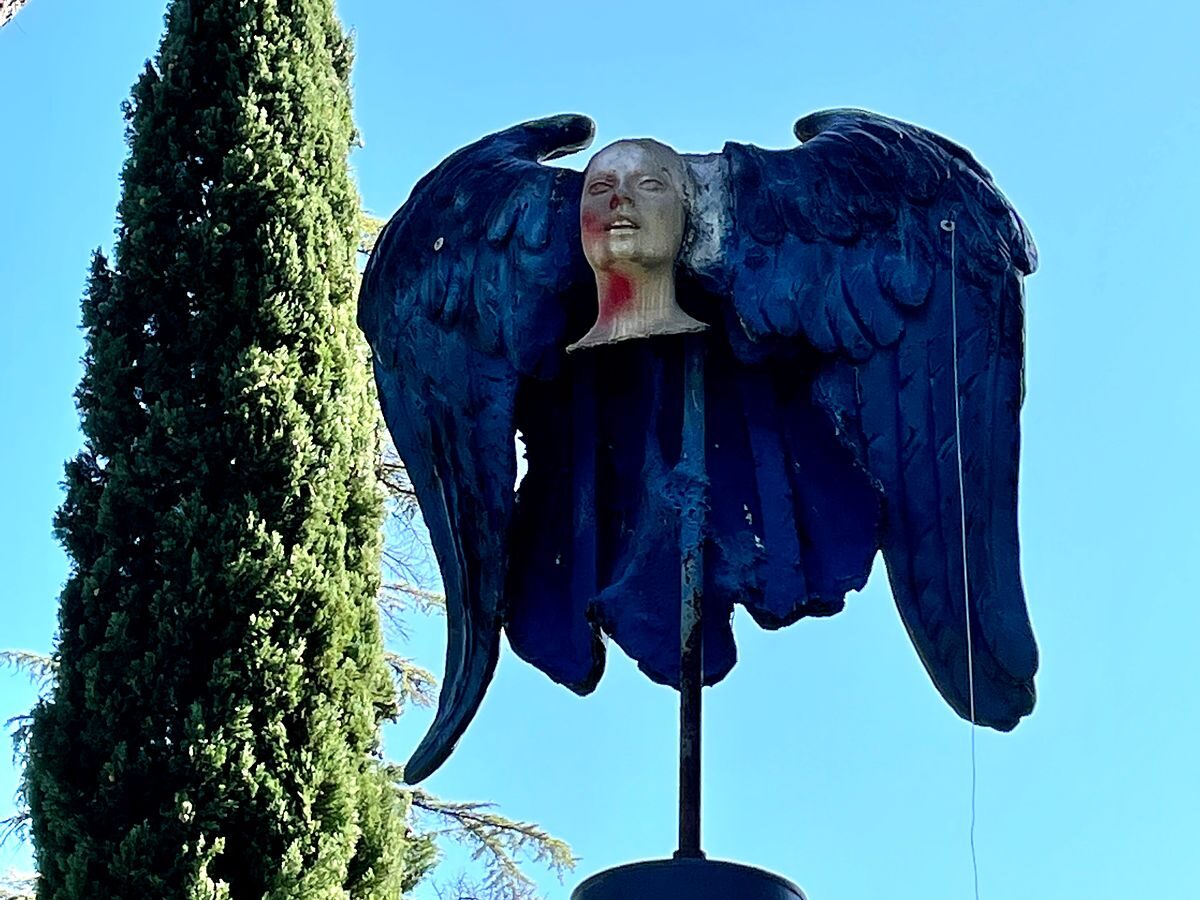 Art in nature at Fondazione Serpone.
Art in nature at Fondazione Serpone.
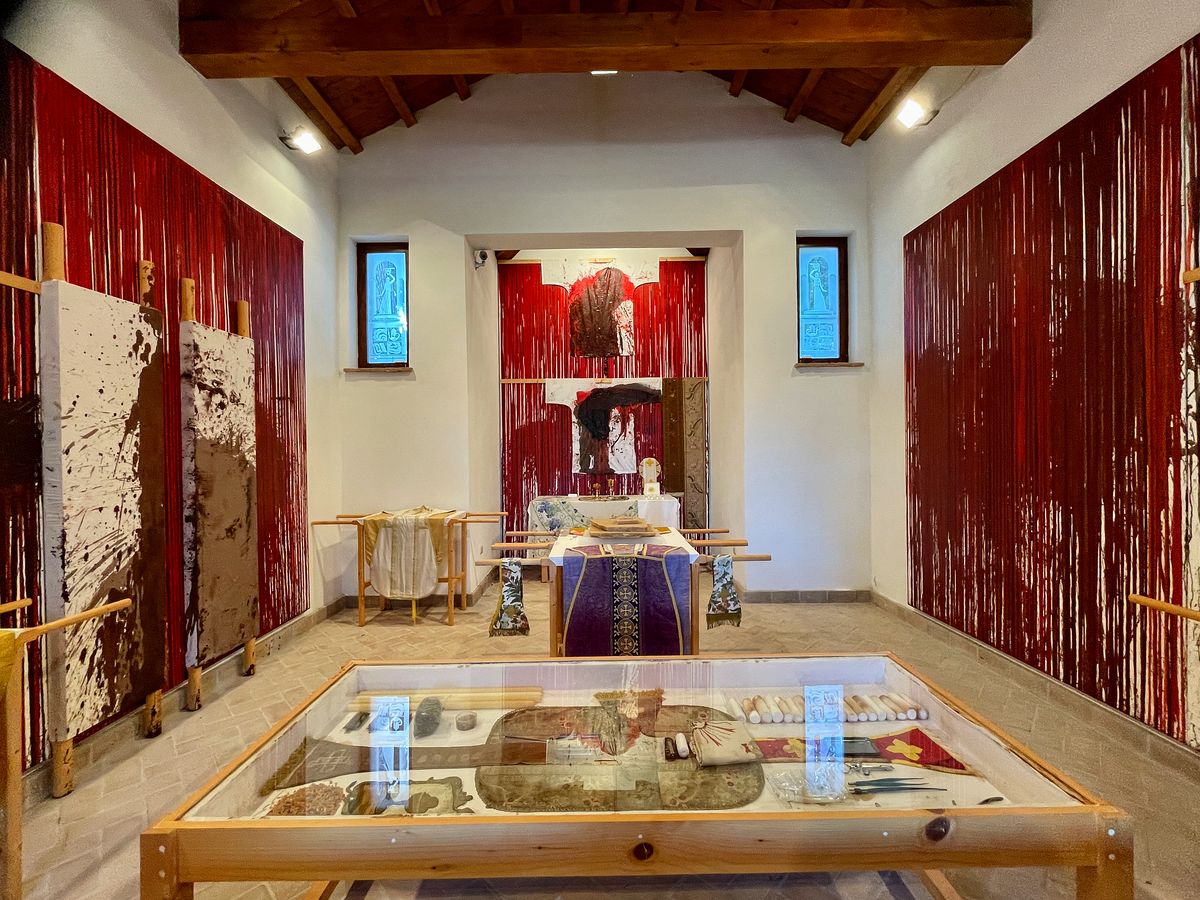 Nitsch Chapel, something to experience.
Nitsch Chapel, something to experience.
Ecofattorie Sabine: terrace lunch on an organic farm
After all that movement and cycling, uphill and down, a bit of restoration and stock-taking is required.
Ecofattorie Sabine in Poggio Mirteto offers an ideal location for a meal before catching the train to Rome. The farm is right there, so everything is fresh, but so is the train station, so you can roll onto the train after your meal.
For lunch, we shared honey-bathed ricotta; gnocchi with pumpkin cream, sheep cheese, sage and crouton crumble; pici pasta with walnut pesto and stracciatella; cicory greens ripassta and an autumn salad. With our meal, we enjoyed a Lazio Tragugnano Orvieto DOC from Sergio Mottura vineyard, an organic white wine blend featuring, again, the Greccheto varietal.
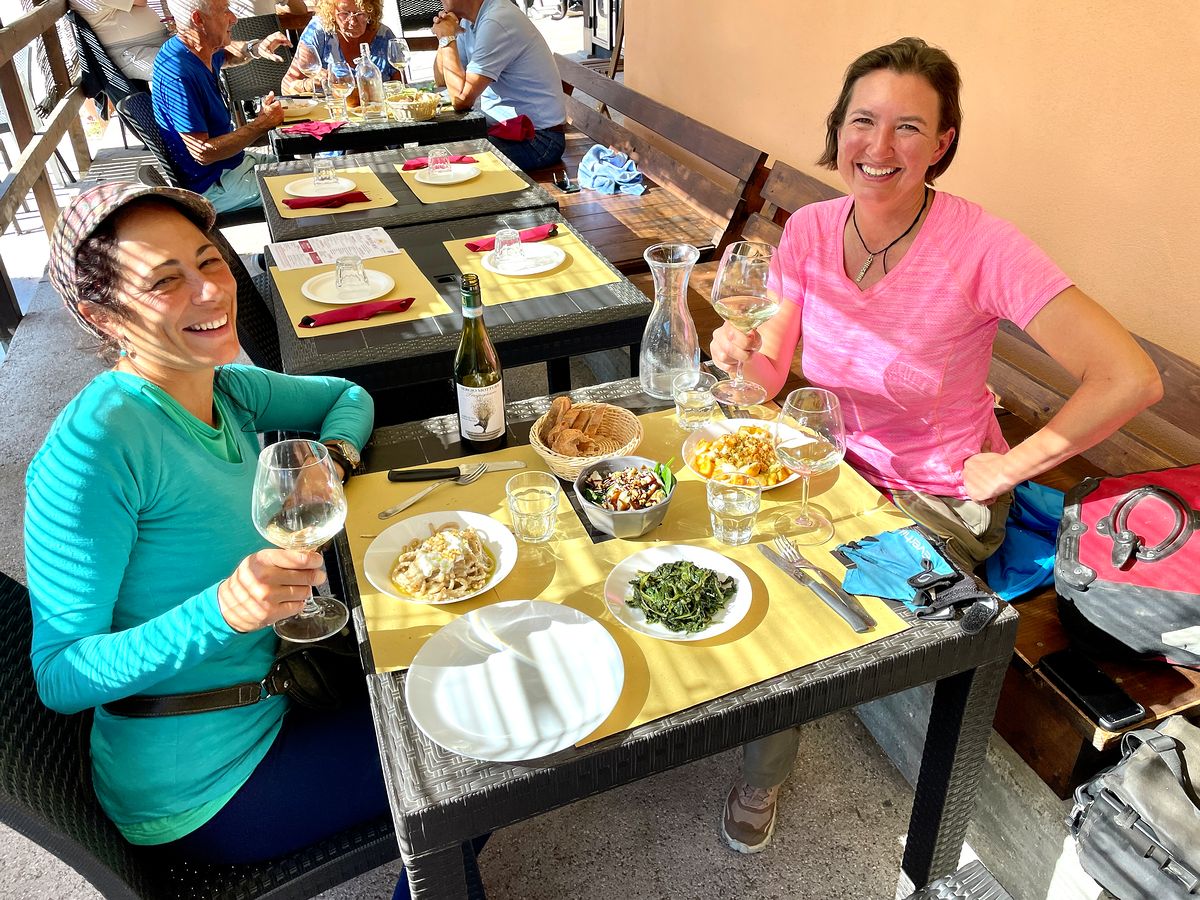 Ecofattorie Sabine, where ingredients are fresh from the organic farm next door.
Ecofattorie Sabine, where ingredients are fresh from the organic farm next door.
III. On Rome's Edge: Ostia, Fiumicino, and Isola Sacra
Everyone knows of Rome, the Eternal City, for its deep history and archeological wonders. However, not too far out of town in the direction of Fiumicino airport lies a handful of remarkable sites that often go unnoticed. ? If you are looking for even more impressive history and ruins without the crowds, check out Ostia Antica and Portus, two nearby Tiber River gateways for commerce and exchange during the Roman Empire.
These lesser known archeological ruins speak to the development and growth of Rome and form the cornerstone of a kind of “Rome you never knew” experience. To connect past to present, our itinerary also included encounters with passionate local people and projects highlighting the link between community, history and nature in and around the surrounding communities of Fiumicino and Isola Sacra.
Ostia Antica: The ancient Roman Empire…just outside Rome
Stroll the ancient streets, homes, theater and businesses of the once thriving ancient city of Ostia, known today as Ostia Antica. Although this site does not garner the attention (or crowds) of the top-tier archeological sites in nearby Rome, nor trigger the kind of emotion you might experience at Pompeii, the evidence of what life was like in this town some 2000 years ago astonishes due to its remarkable state of preservation. Marble-topped bars? Ostia Antica had them. Street food stalls? Those too. Maybe that's why Ostia Antica is considered among Rome's first colonies despite its proximity to Rome itself.
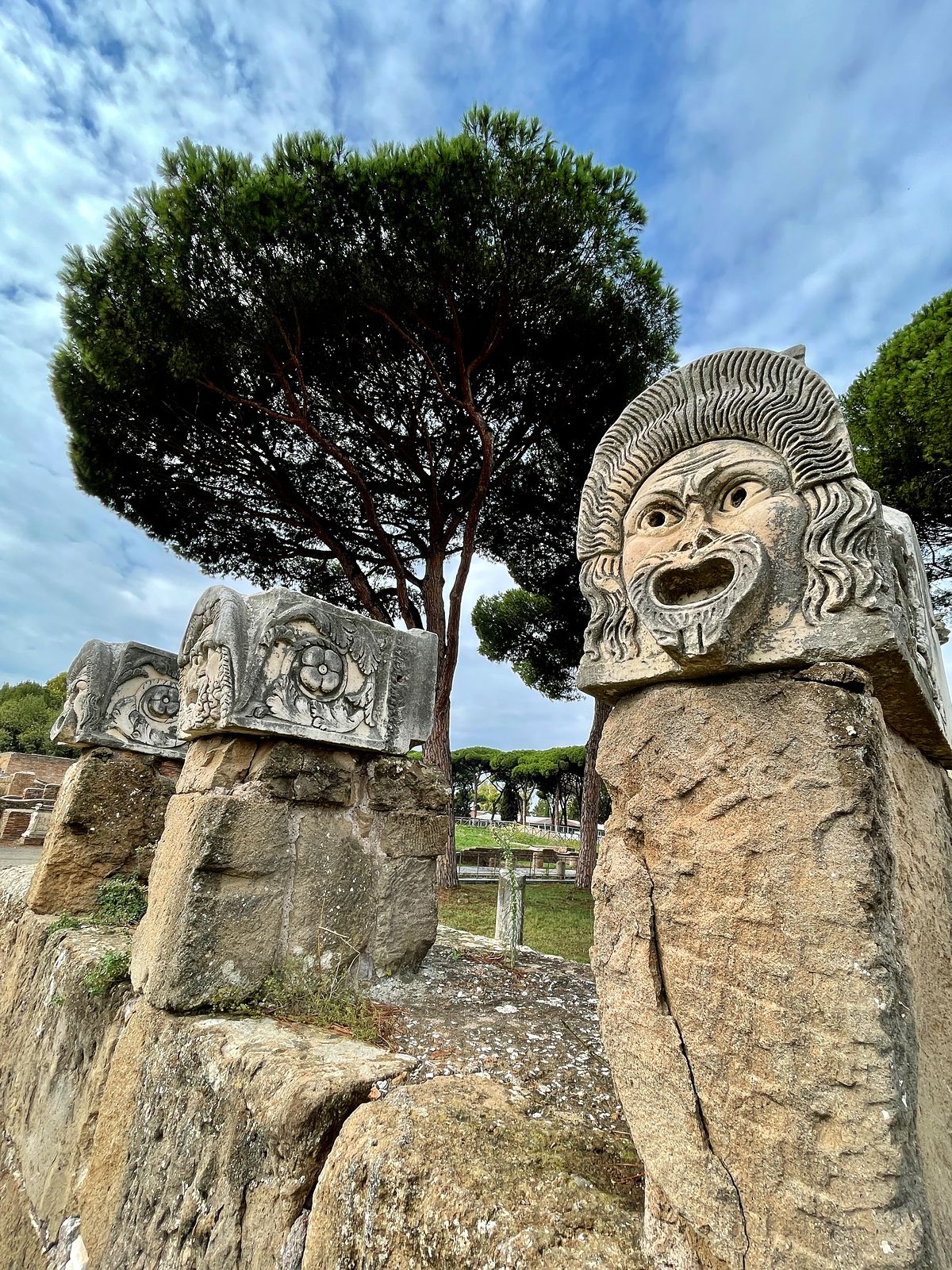 Theater mask sculptures in the Roman Theatre, Ostia Antica.
Theater mask sculptures in the Roman Theatre, Ostia Antica.
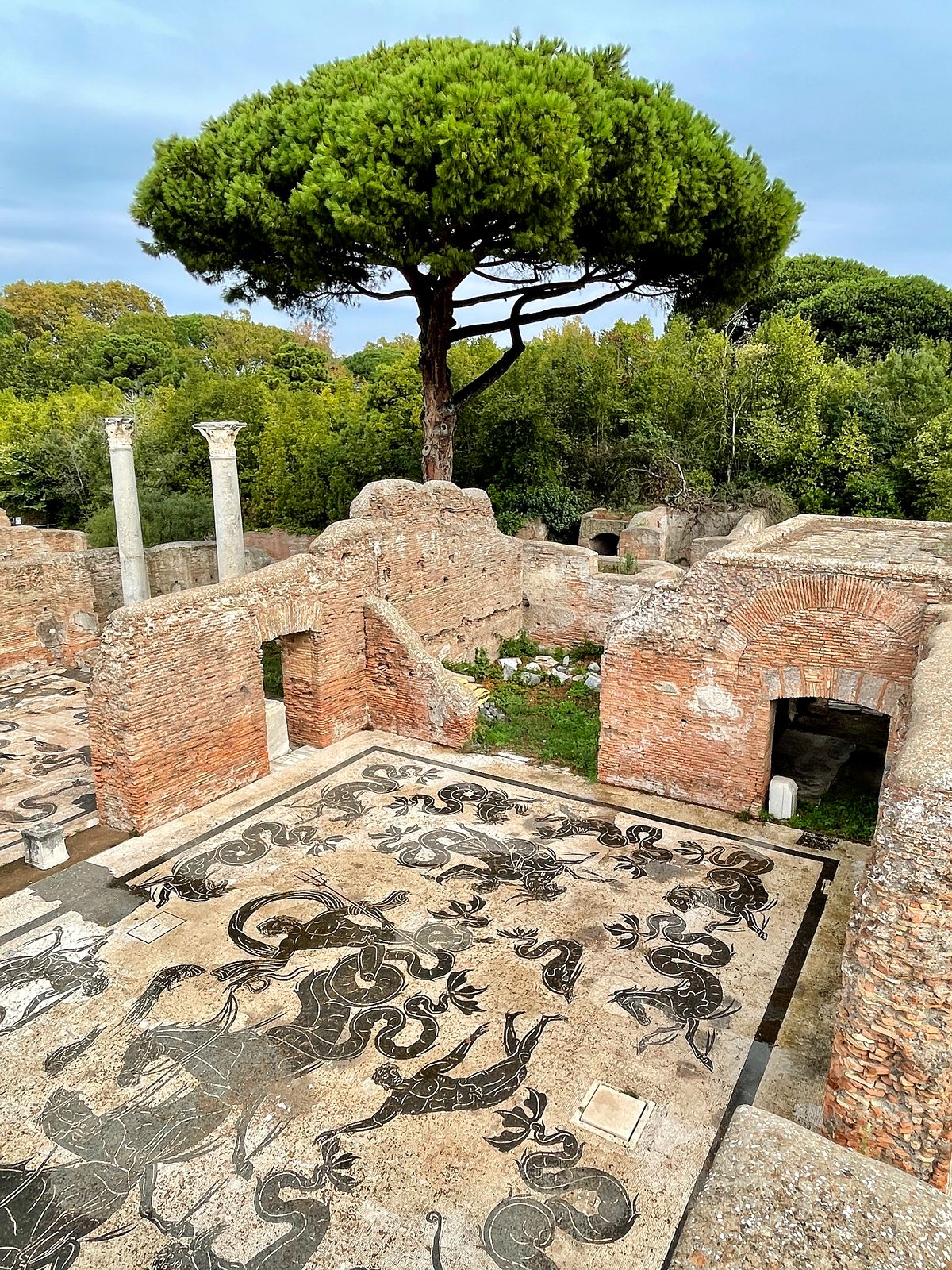 Mosaics in the Roman baths of the chariot drivers, Ostia Antica.
Mosaics in the Roman baths of the chariot drivers, Ostia Antica.
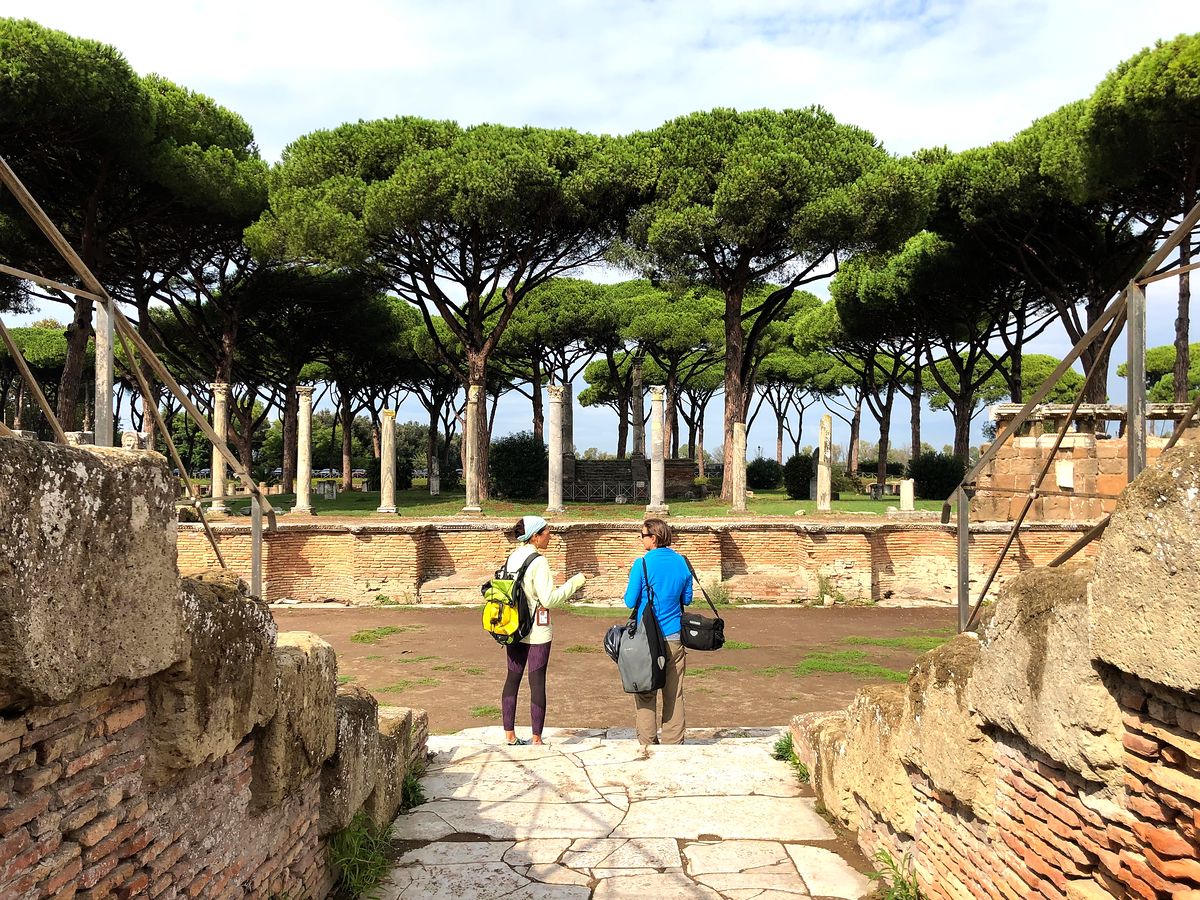 The 1st century A.D. Roman amphitheater of Ostia Antica. It's still in use today.
The 1st century A.D. Roman amphitheater of Ostia Antica. It's still in use today.
Portus (The Port of Claudius and the Harbor of Trajan)
Just down the road from Ostia Antica in the direction of Fiumicino (home to Rome's airport FCO) lies Portus and the Archaeological Area of the Imperial Harbours of Claudius and Trajan. Imagine the bustling ancient city of Portus while strolling the stone-quiet ruins of the Port of Claudius (42 AD) and Harbor of Trajan (100 AD).
Today, this archeological site is 3 km from the Mediterranean coastline, making it difficult to imagine that 2,000 years ago this artificial, hexagon-shaped harbor was fully submerged and served as Rome's main port to the Mediterranean Sea.
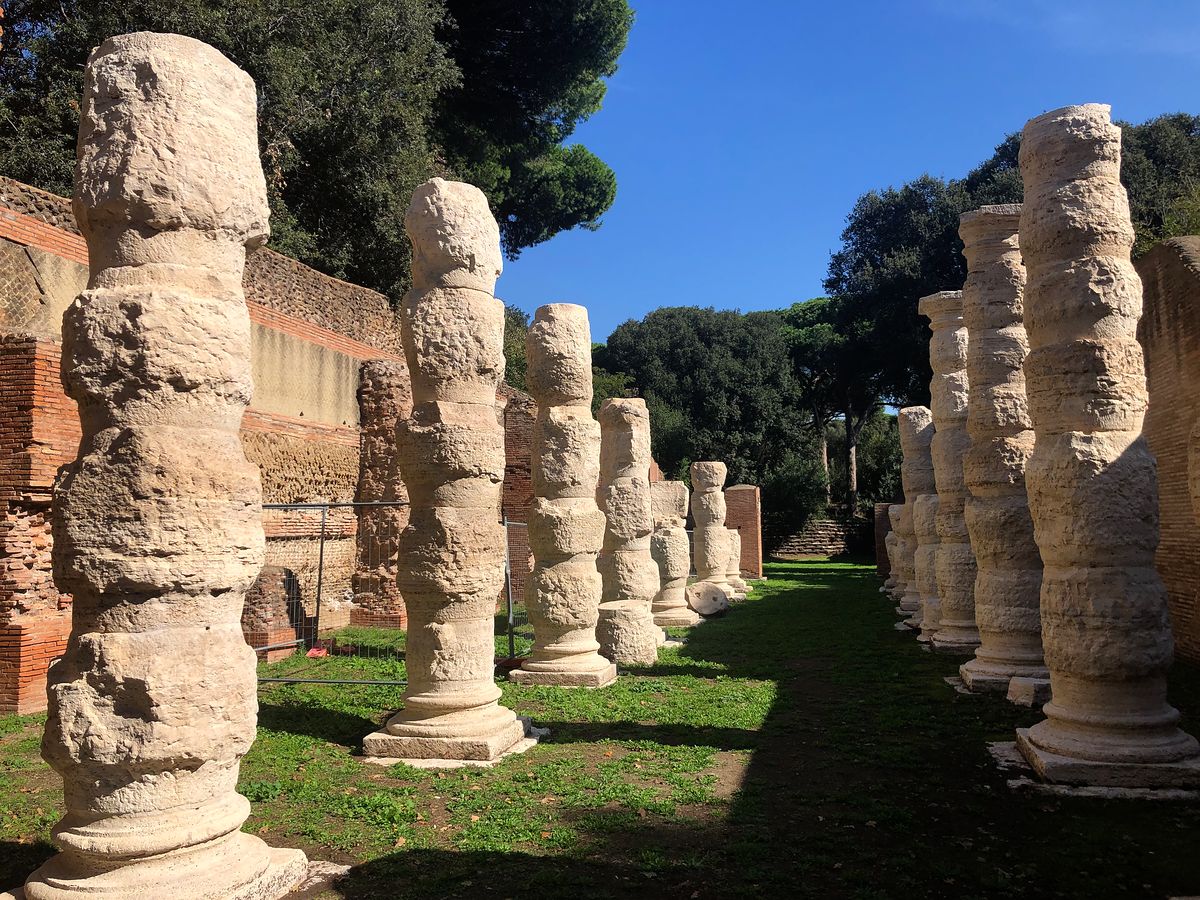 Portus, once ancient Rome's main port on the Mediterranean.
Portus, once ancient Rome's main port on the Mediterranean.
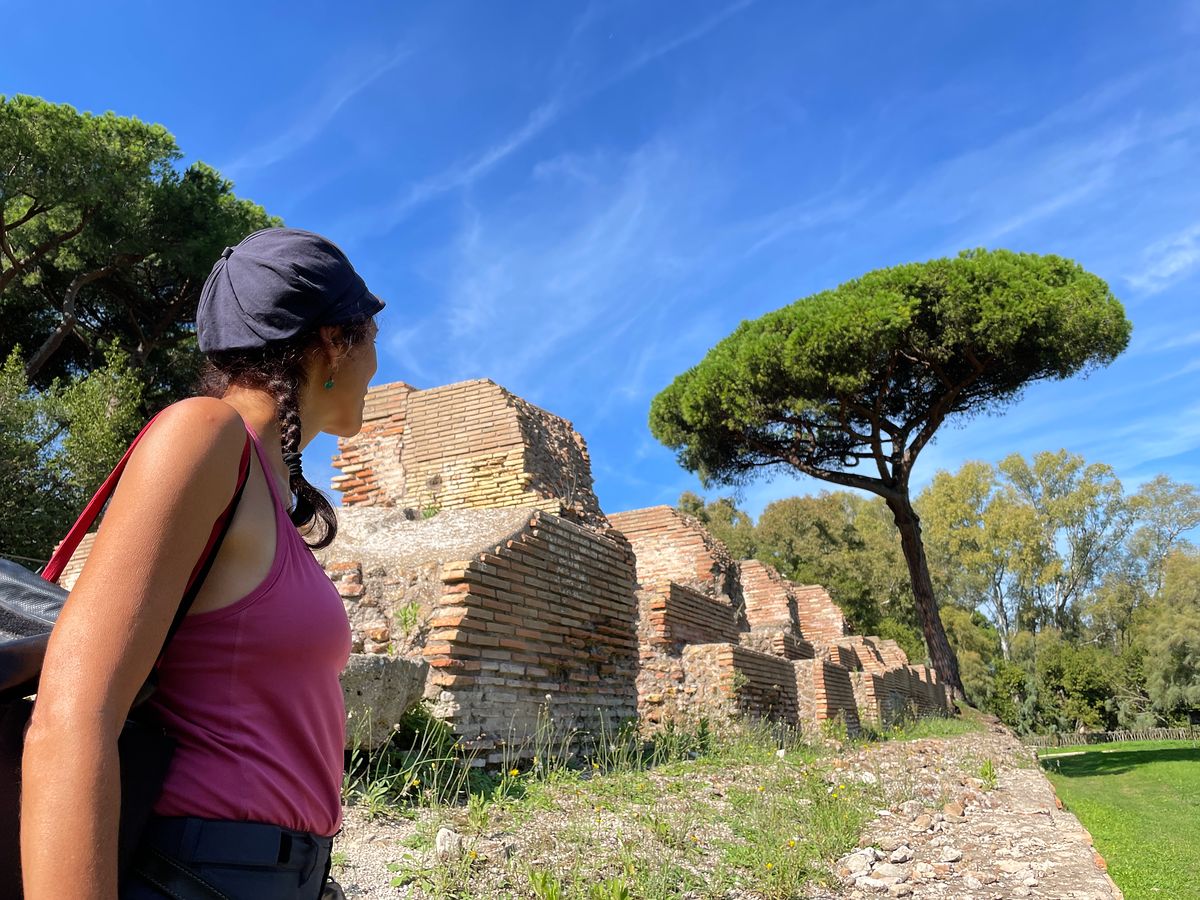 Severiani warehouses, Portus.
Severiani warehouses, Portus.
Goods arriving by sea were unloaded at the port and harbor, then transferred to smaller boats on the Tiber River to take to Rome. This configuration allowed Rome access to the Mediterranean Sea along with a layer of protection.
Portus grew in such size and importance that it received the status of an independent city in the 4th century. However, history consigned the port to disuse. Much of it remains undiscovered, quite literally underground, so one can only imagine what lies underneath the airport and the nearby towns of Fiumicino and Isola Sacra.
Explore the ancient tombs at the Necropolis of Portus
If you wish to understand the ancients, understand how they honored, buried and stored their dead.
The Necropolis of Portus in Isola Sacra is a vast cemetery dating from the 1st century A.D. Although the well-off at the time could afford mausoleums and tombs whose epic mosaic floors remain intact even today, workers from the Roman port and harbor and tradesmen of various crafts were relegated to packed burial niches and much tighter quarterage.
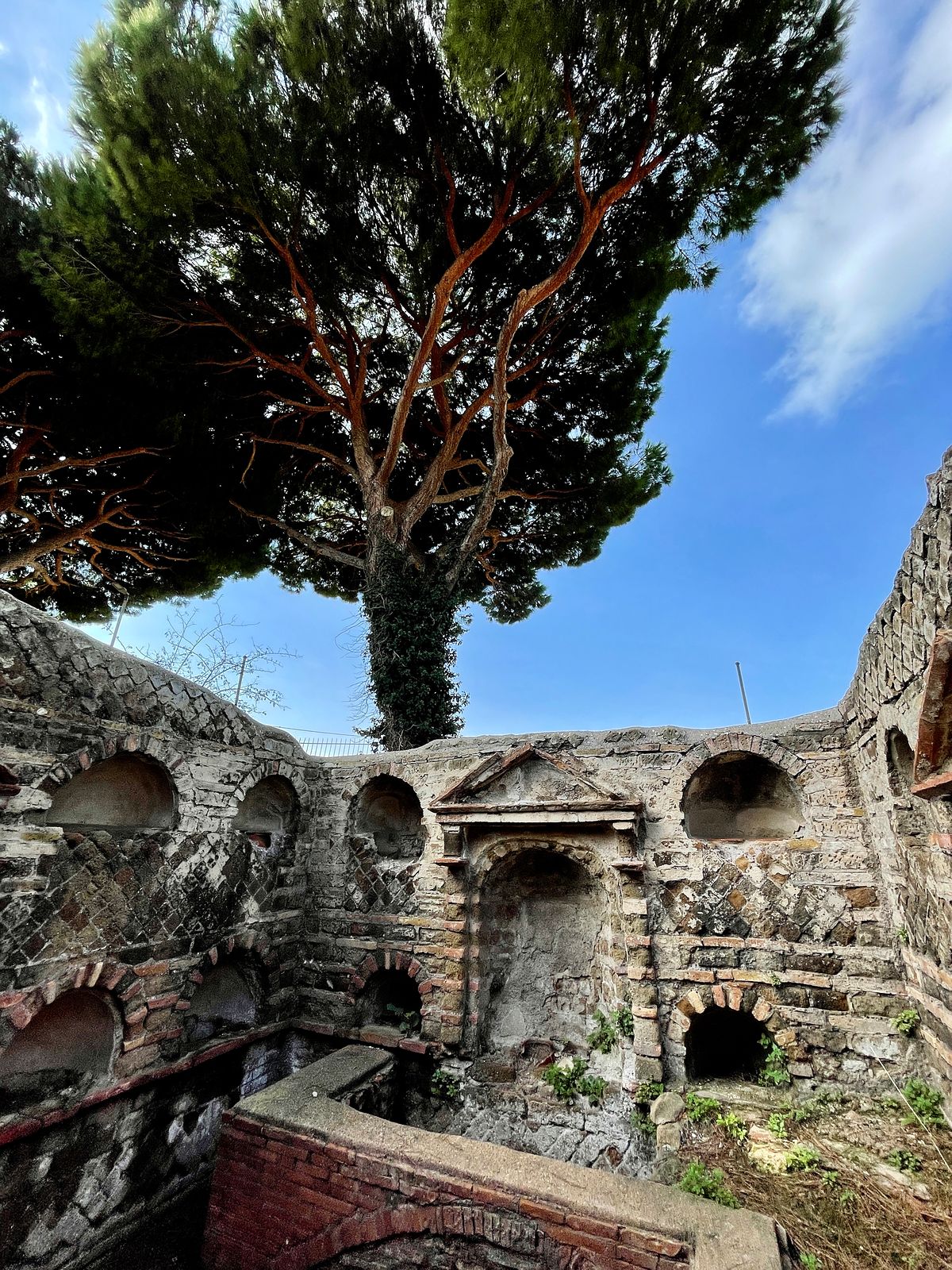 Mausoleums and burial niches, Portus Necropolis.
Mausoleums and burial niches, Portus Necropolis.
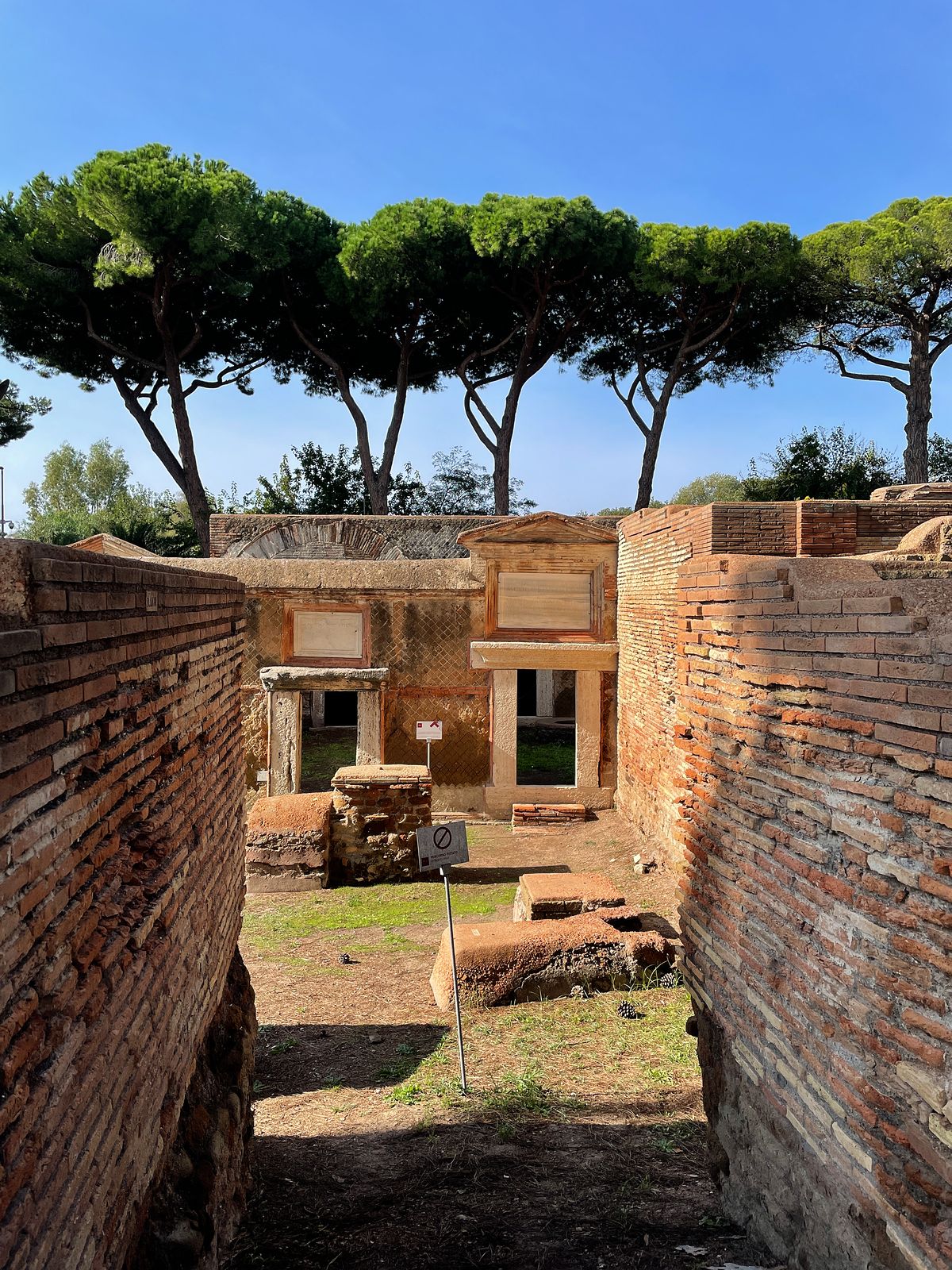 Tomb layers, Portus Necropolis.
Tomb layers, Portus Necropolis.
The site is absolutely worth a visit. The necropolis and its surroundings combines the tranquility you'd expect from a burial site with the wonder and story of a cache of archaeological ruins offering a glimpse into the lives and livelihoods of those who helped build the surrounding history.
Eat and drink local in Fiumicino
For lunch on the Tiber River near a marina in Fiumicino, we enjoyed 4112 – QuarantunoDodici Restaurant, a more laid back bistro version of the Michelin-starred Il Tino restaurant upstairs
Resisting an urge to try everything on the menu, we reined it in and opted for a palate cleansing starter, the merluzzo (salted codfish) and red beet carpaccio dashed with raspberry vinegar. Appreciating the scratch pad of the seven local species of fresh fish on offer, we shared a whole sarago, a kind of Mediterranean bream not to be confused with either branzino or orata. Distinct, tasty and light. We went bold and paired it all with a Fioranello Bianco from Lazio.
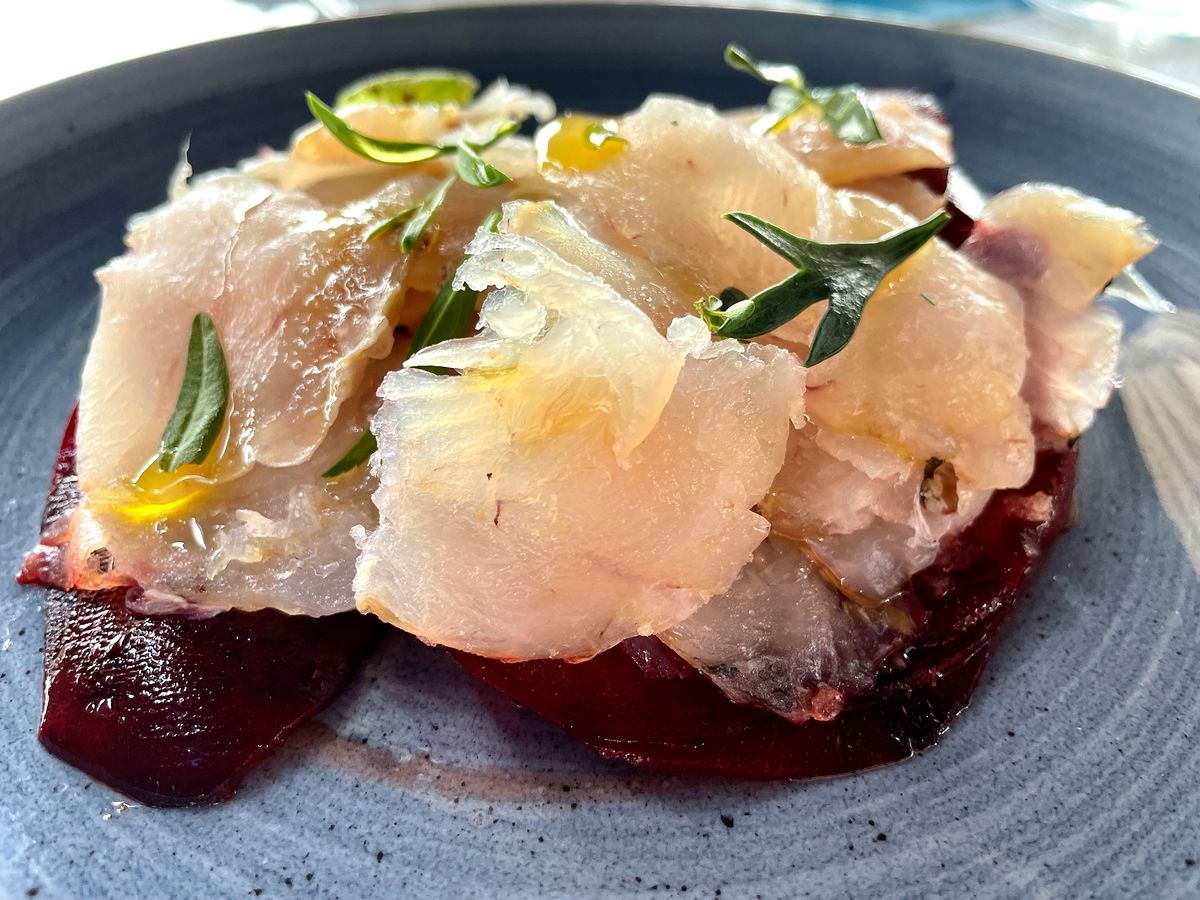 Codfish and red beet carpaccio. QuarantunoDodici (1441) restaurant, Fiumicino.
Codfish and red beet carpaccio. QuarantunoDodici (1441) restaurant, Fiumicino.
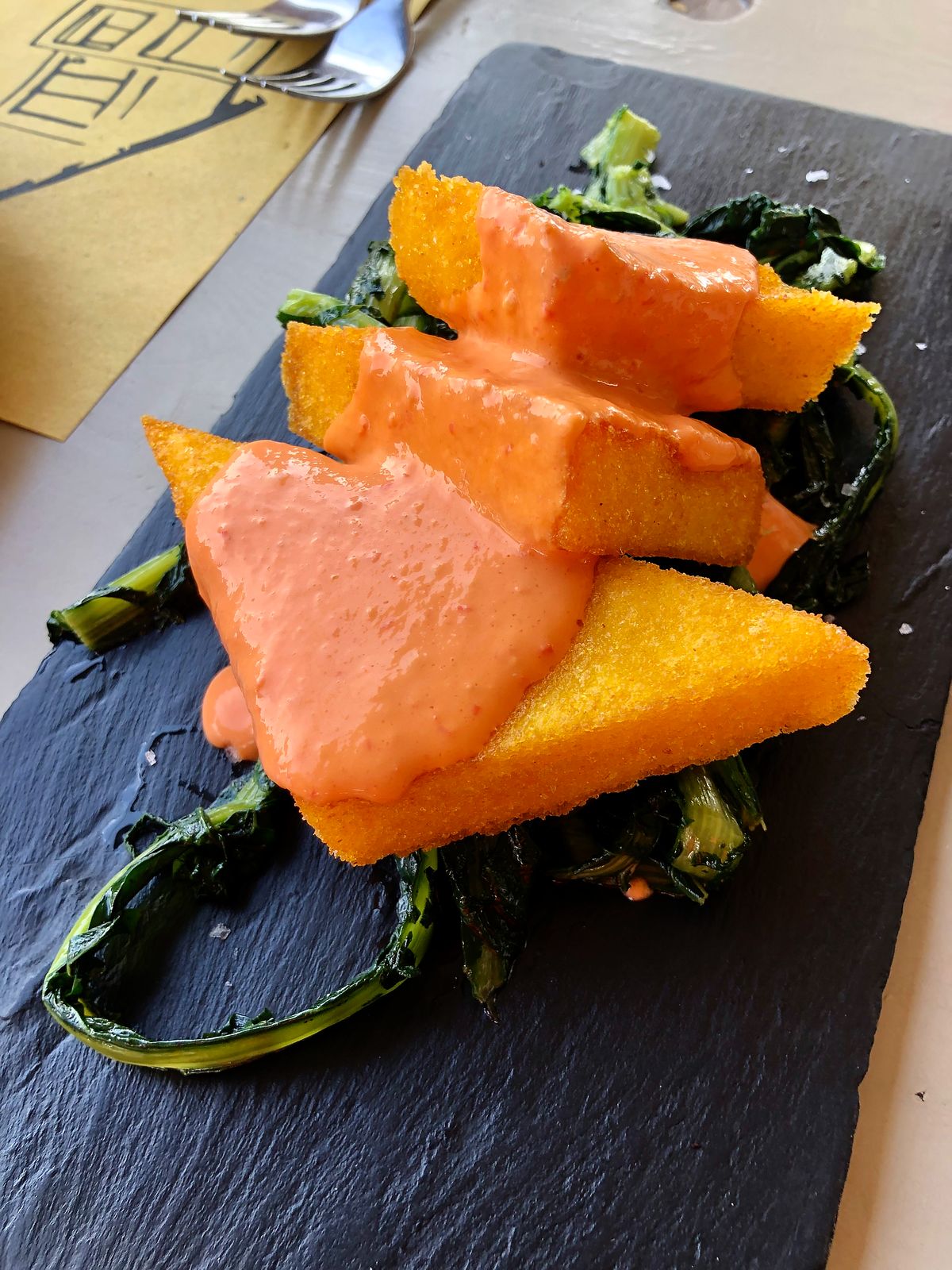 Fried polenta and tomato cream atop cicoria greens, BioAgricola Triano.
Fried polenta and tomato cream atop cicoria greens, BioAgricola Triano.
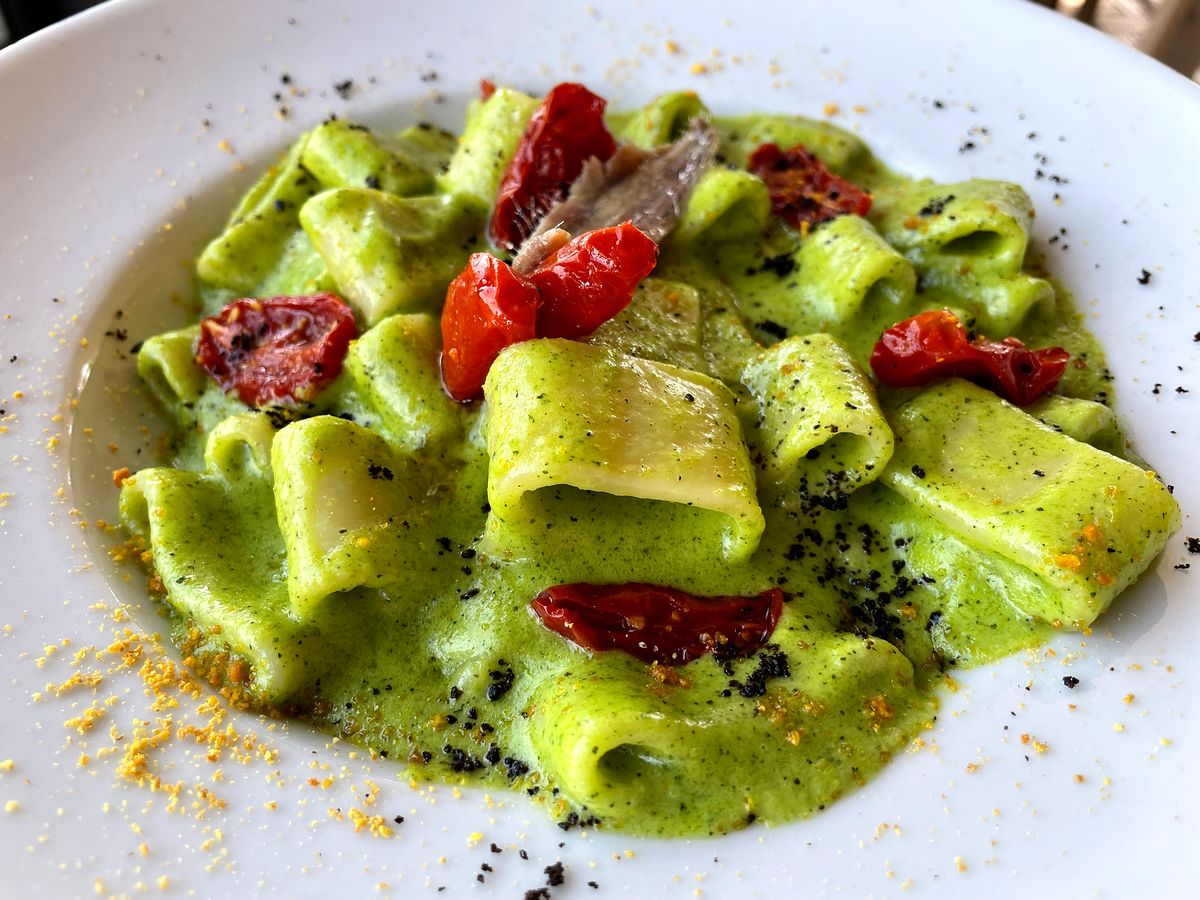 Homemade pasta in zucchini pesto, BioAgricola Triano.
Homemade pasta in zucchini pesto, BioAgricola Triano.
When we were in Fiumicino poking around the Port of Claudius and Harbor of Trajan, we stopped by nearby Bioagricola Traiano for lunch. The restaurant is located on the edge of its organic garden, chicken hut and bee hives so you can imagine the source of many of the ingredients you see on the regularly changing menu.
We opted for a couple of appetizers and pasta dishes, including fried polenta over cicoria greens and homemade pasta with zucchini pesto. Meals are visually appealing and tasty enough, but portions are big and hearty so beware of over-ordering as we did.
Meet a local historian at Museo della Cultura Contadina
?Past and present come together at the Museo della Cultura Contadina in Isola Sacra. Our host, Oswaldo, shared the history of the area and how it had been transformed from a swamp — they literally drained the swamp — into a productive tract of agricul





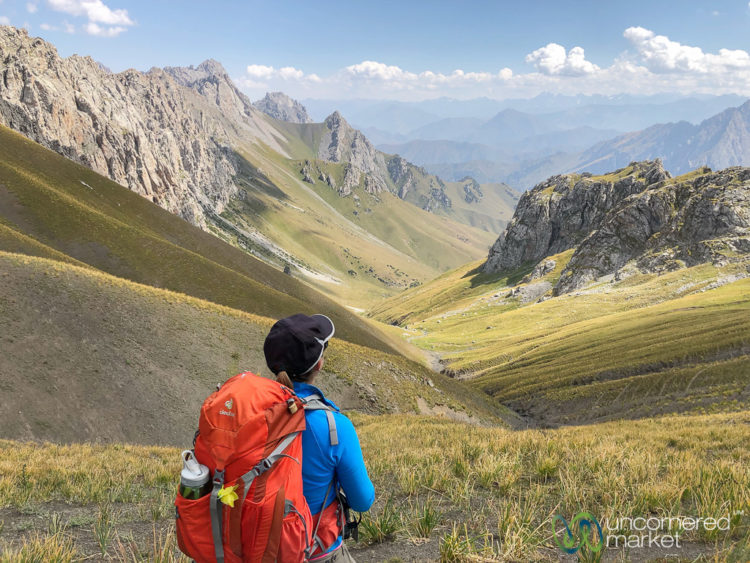
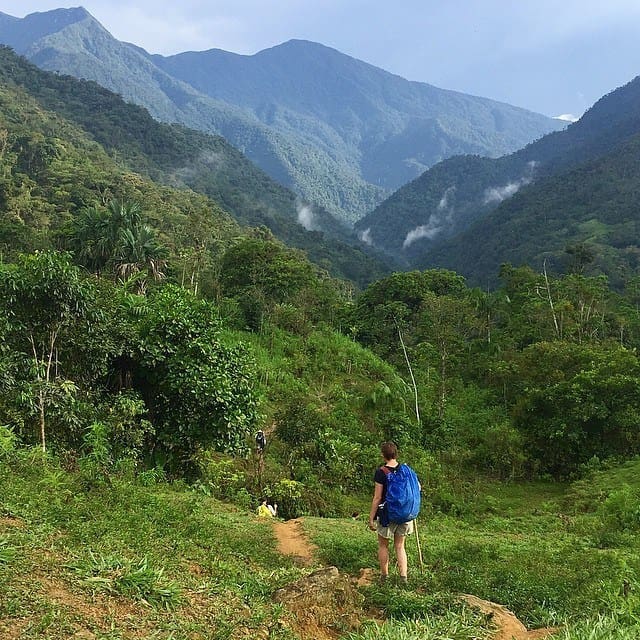
![Berlin Christmas Markets: The Ultimate Guide [Updated 2022]](https://uncorneredmarket.com/wp-content/uploads/2017/10/Berlin_Christmas_Markets_Gendarmenmarkt.jpg)
